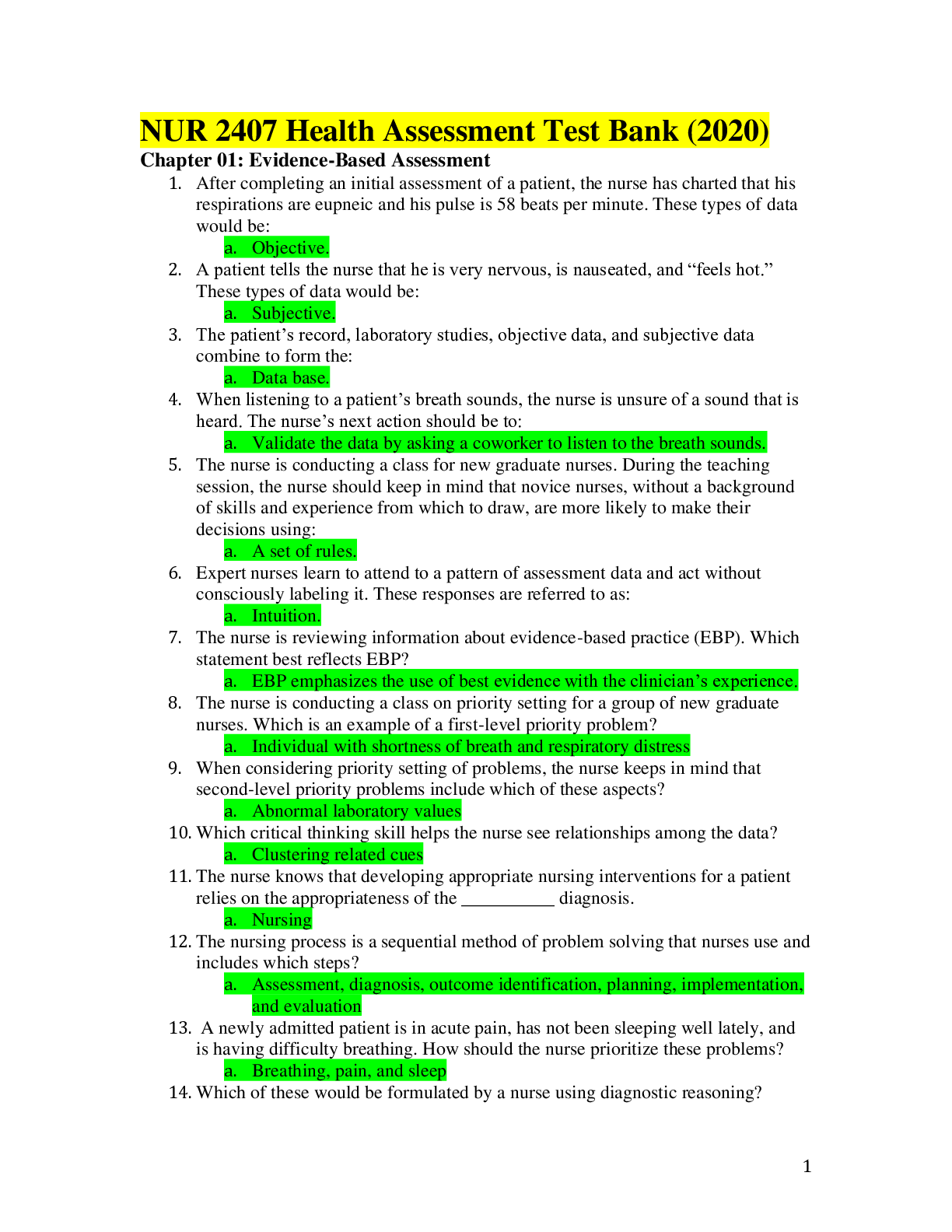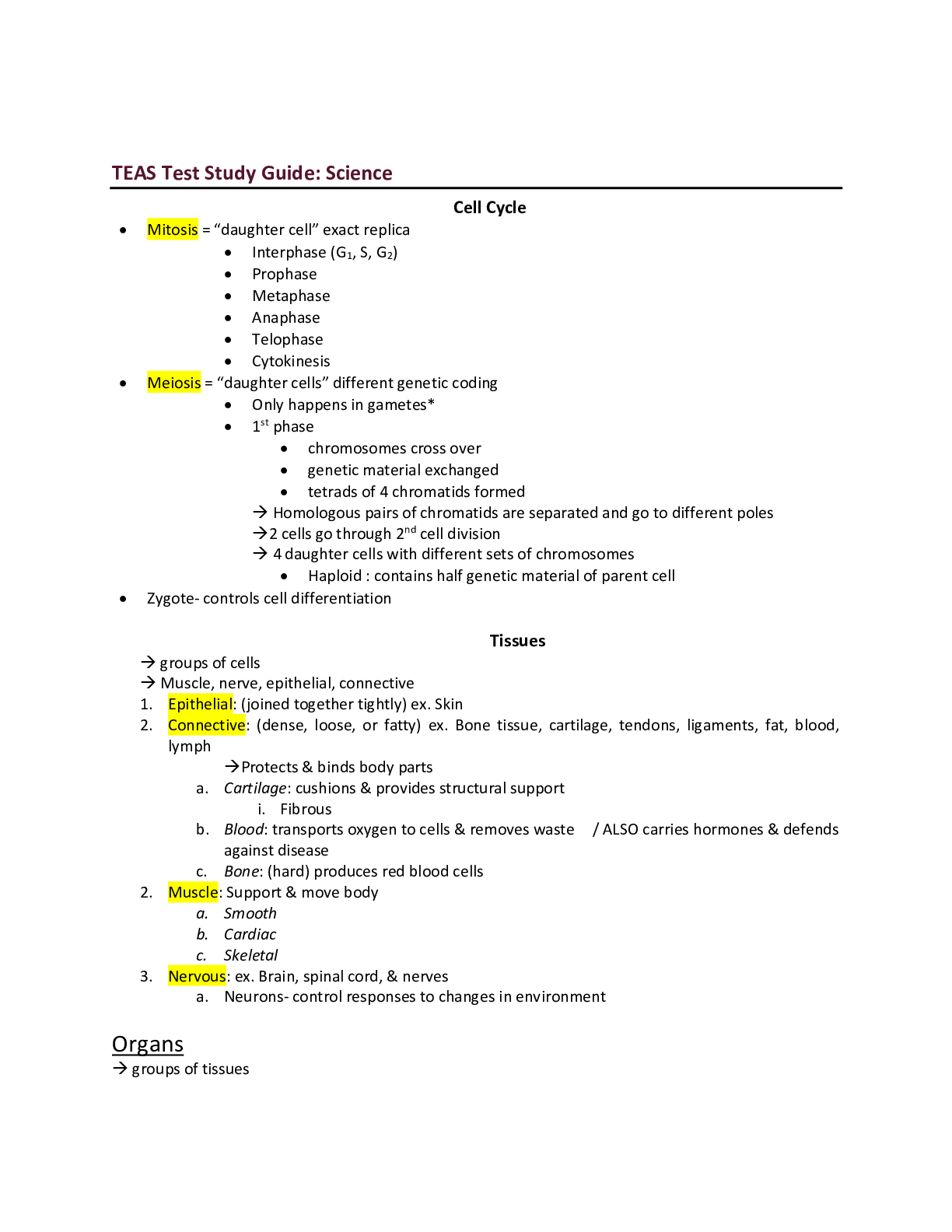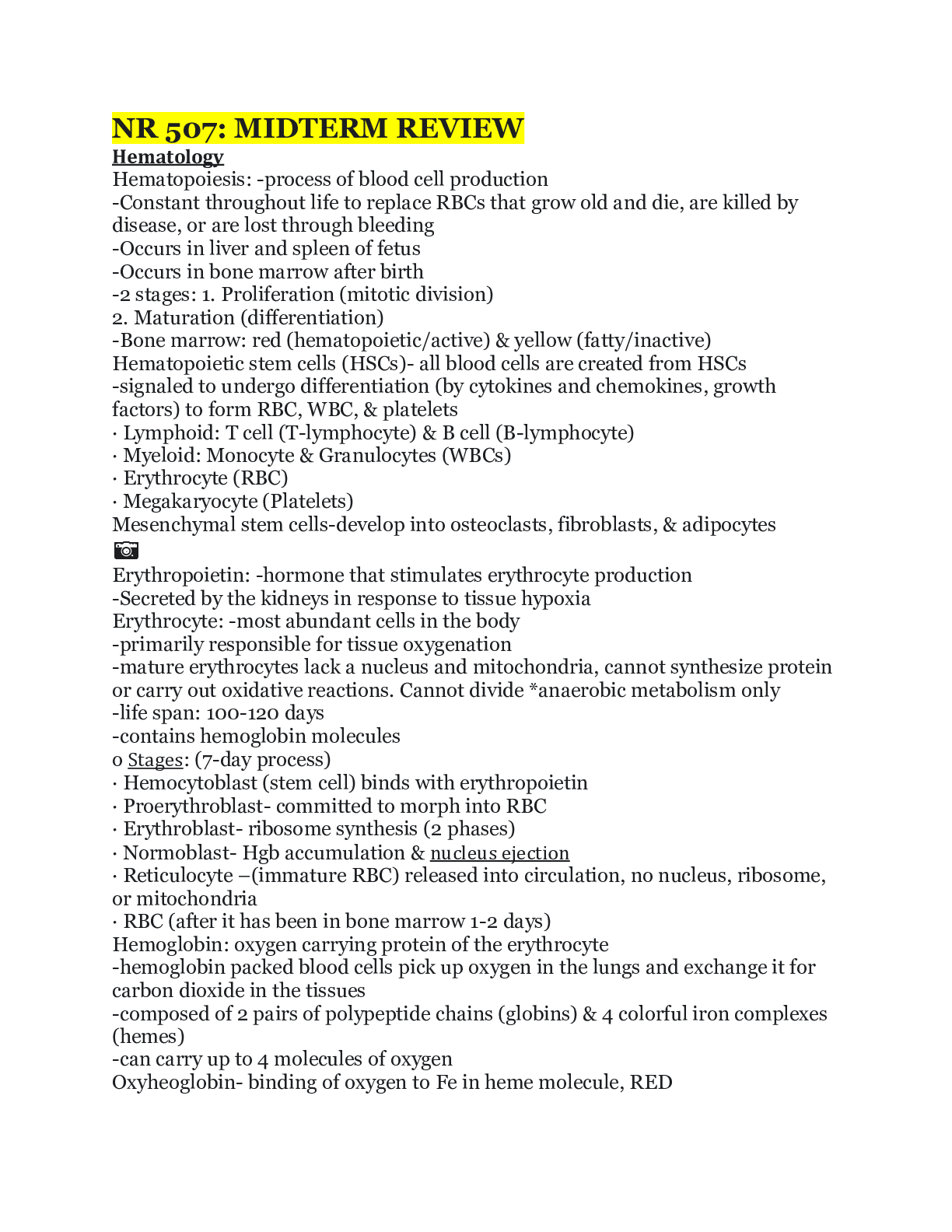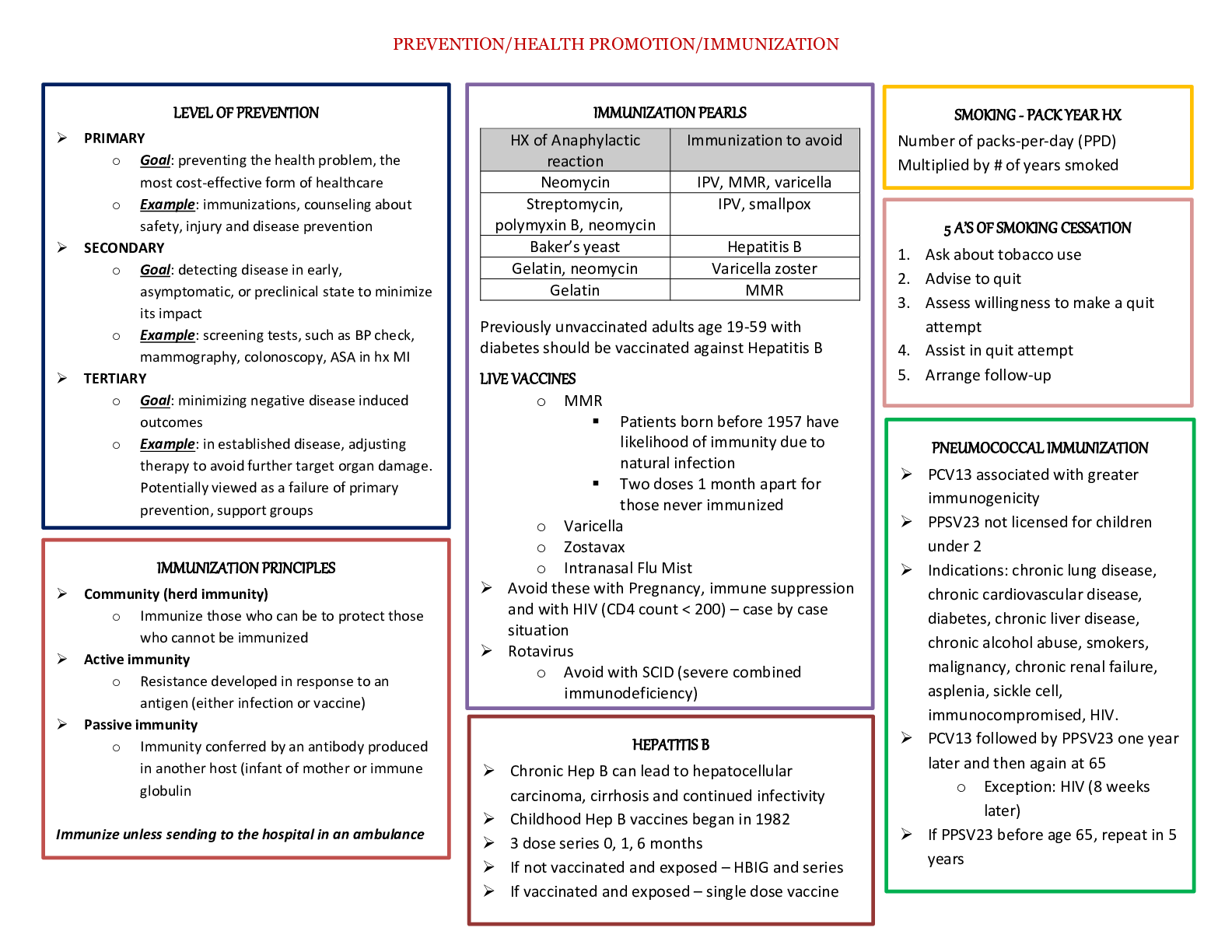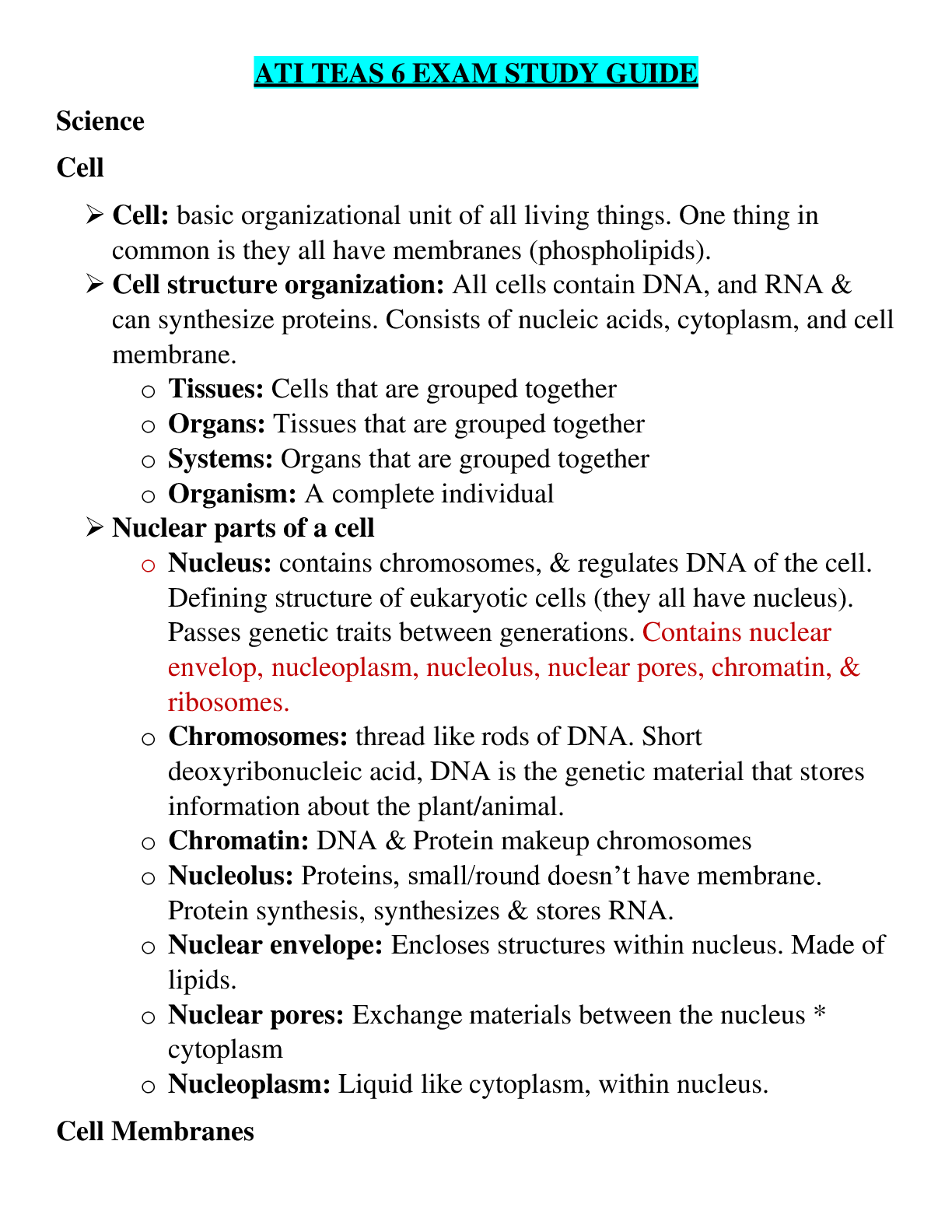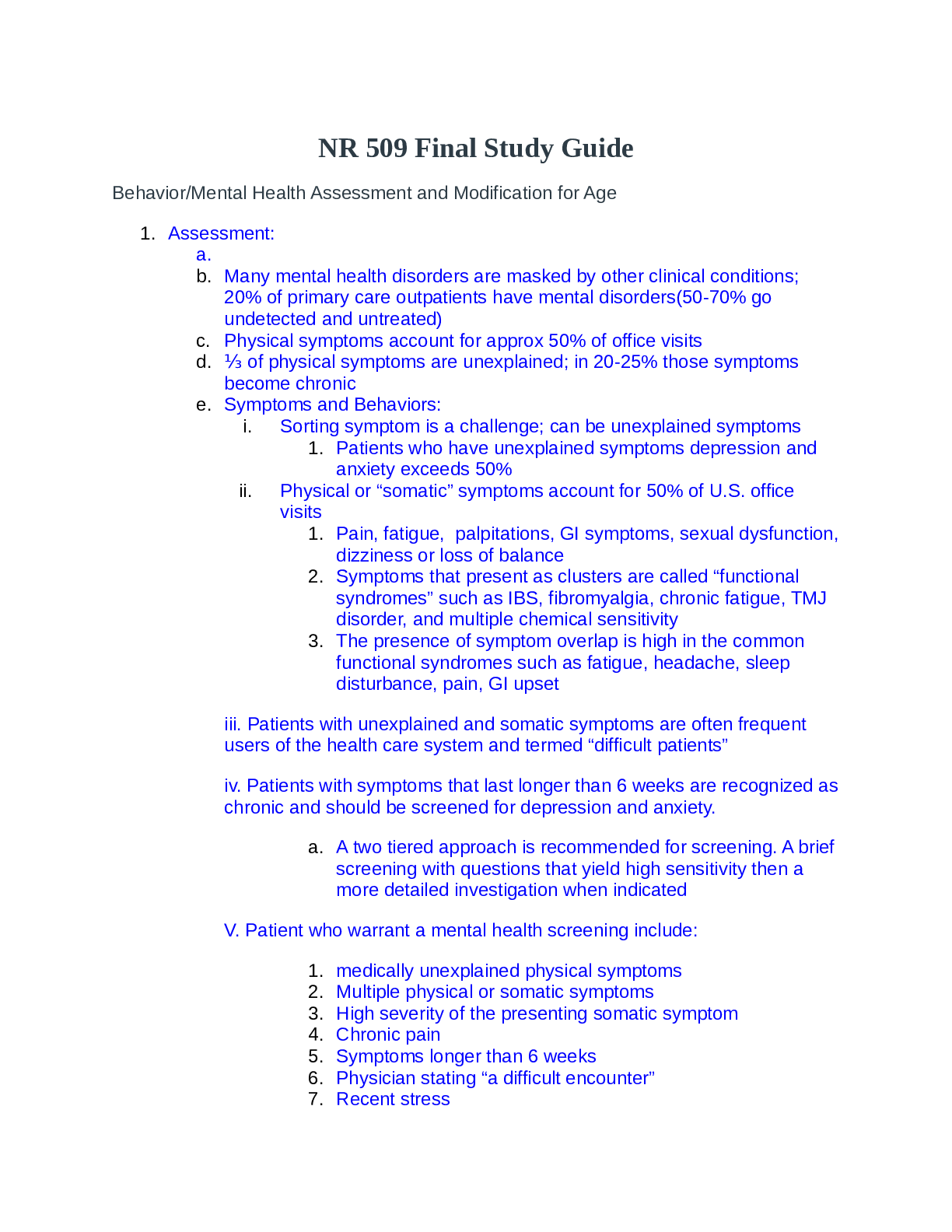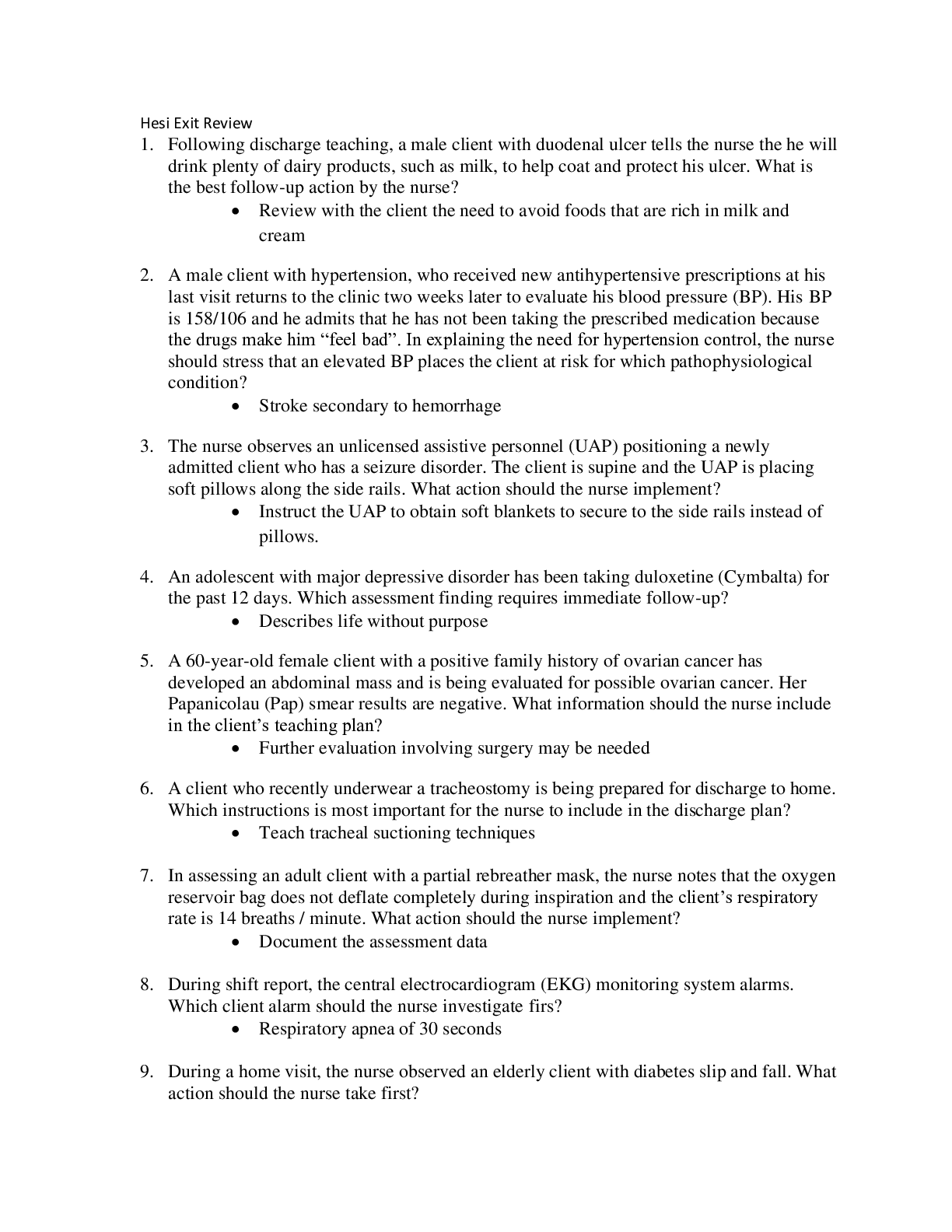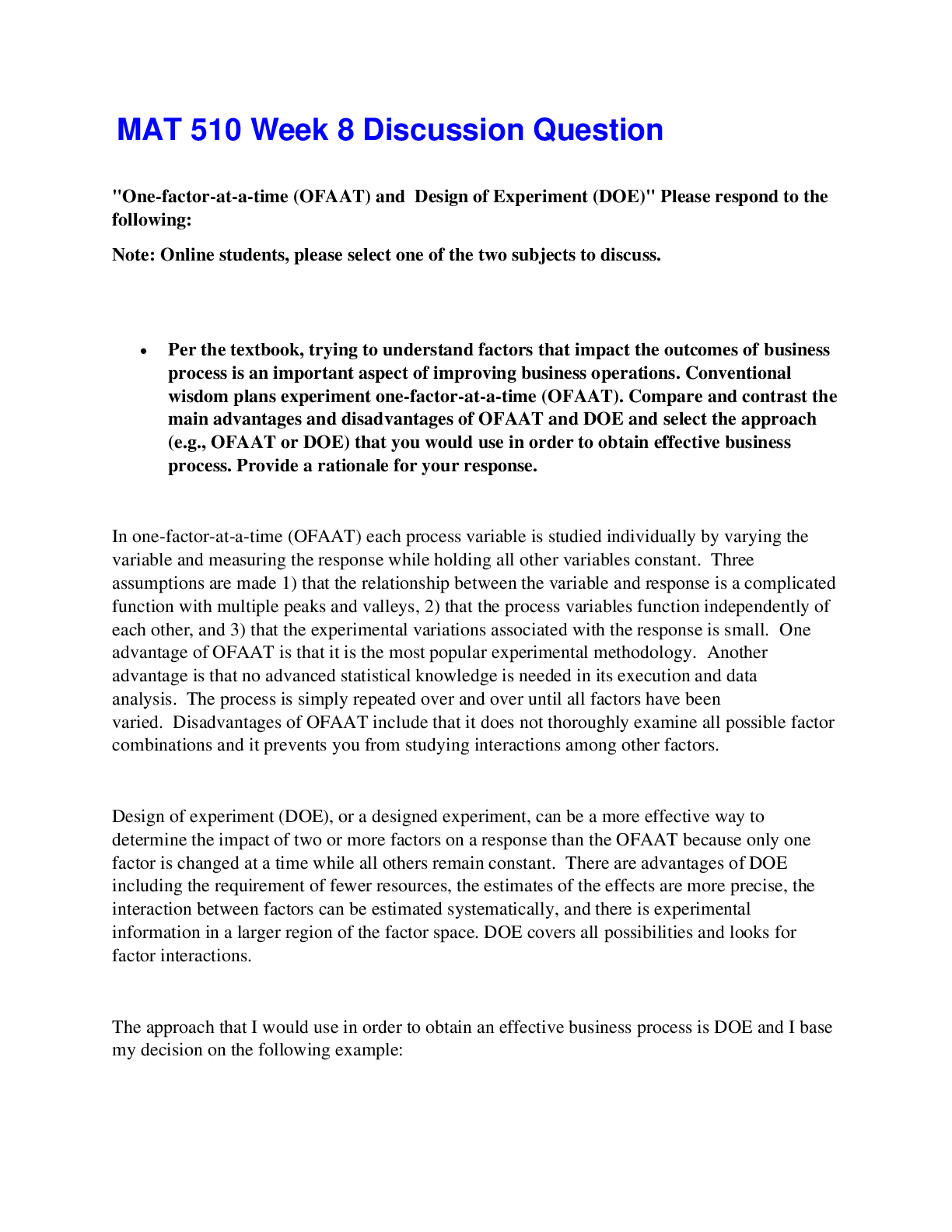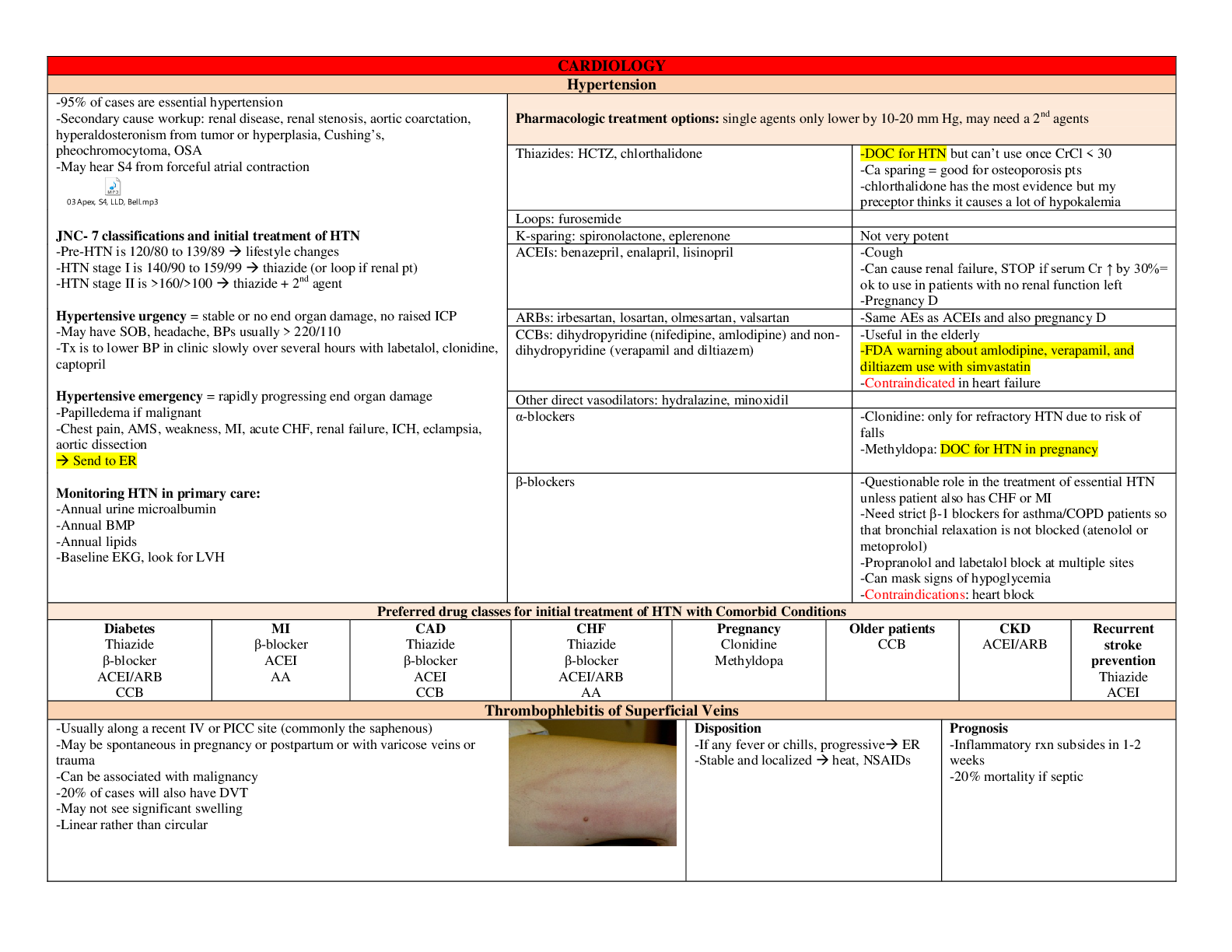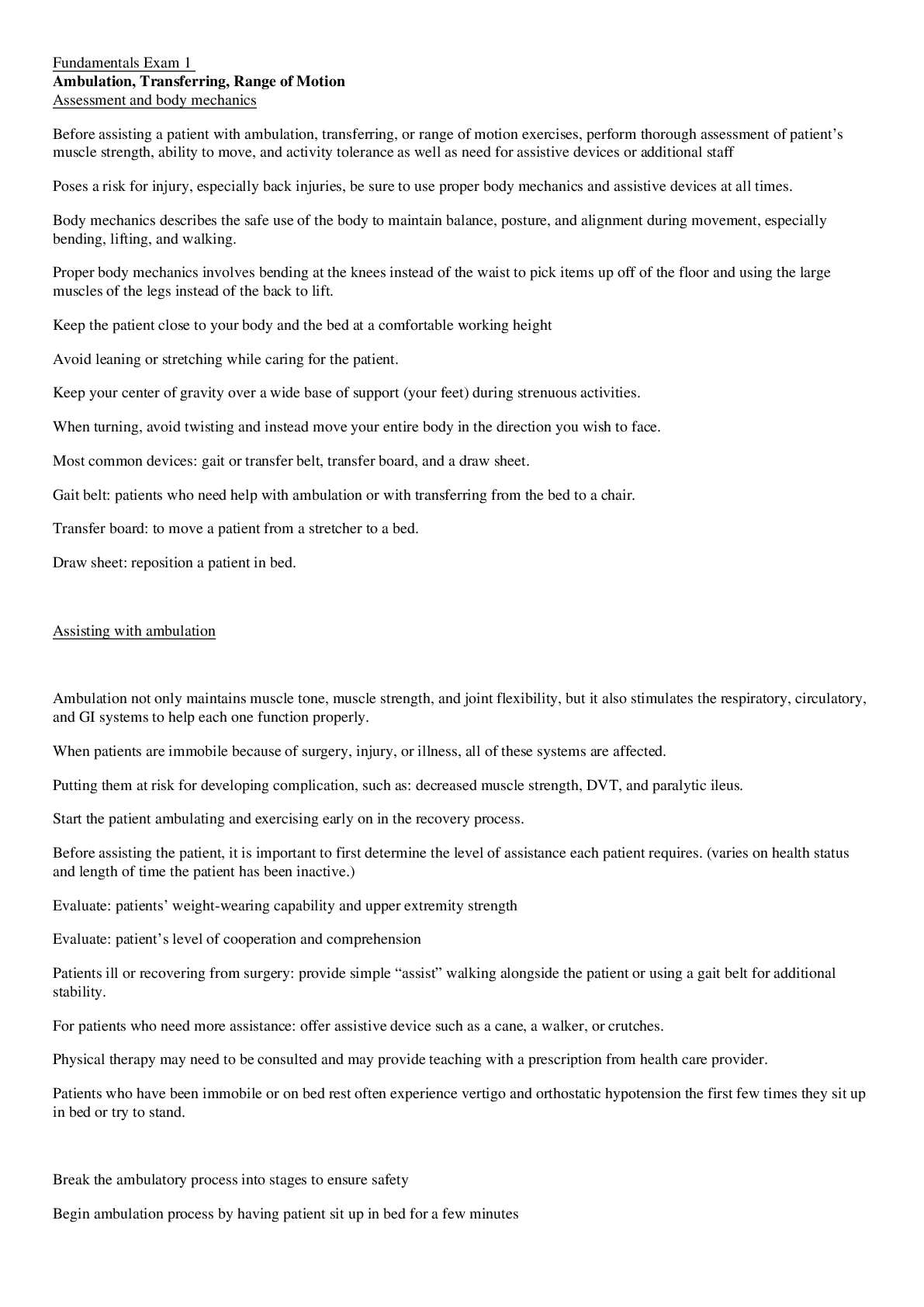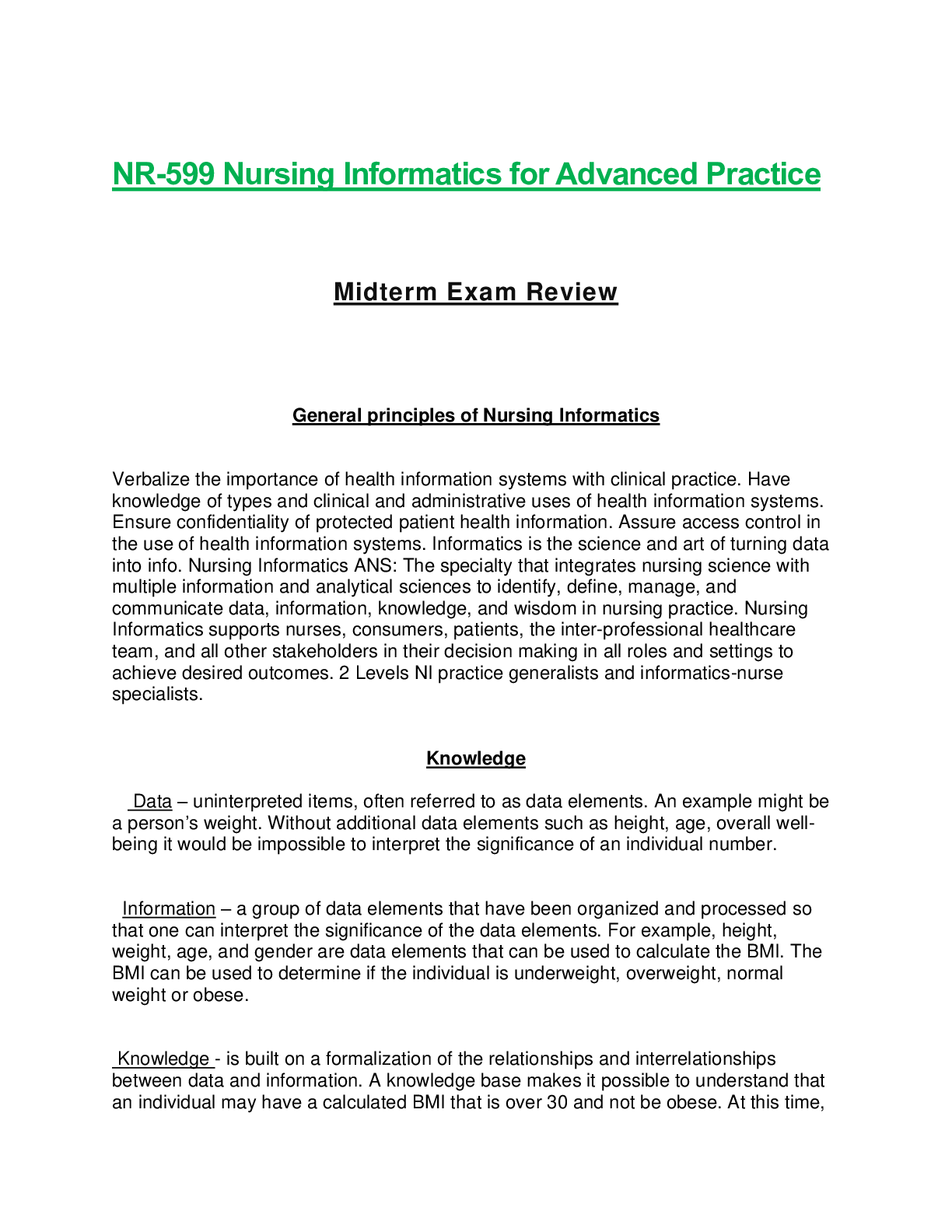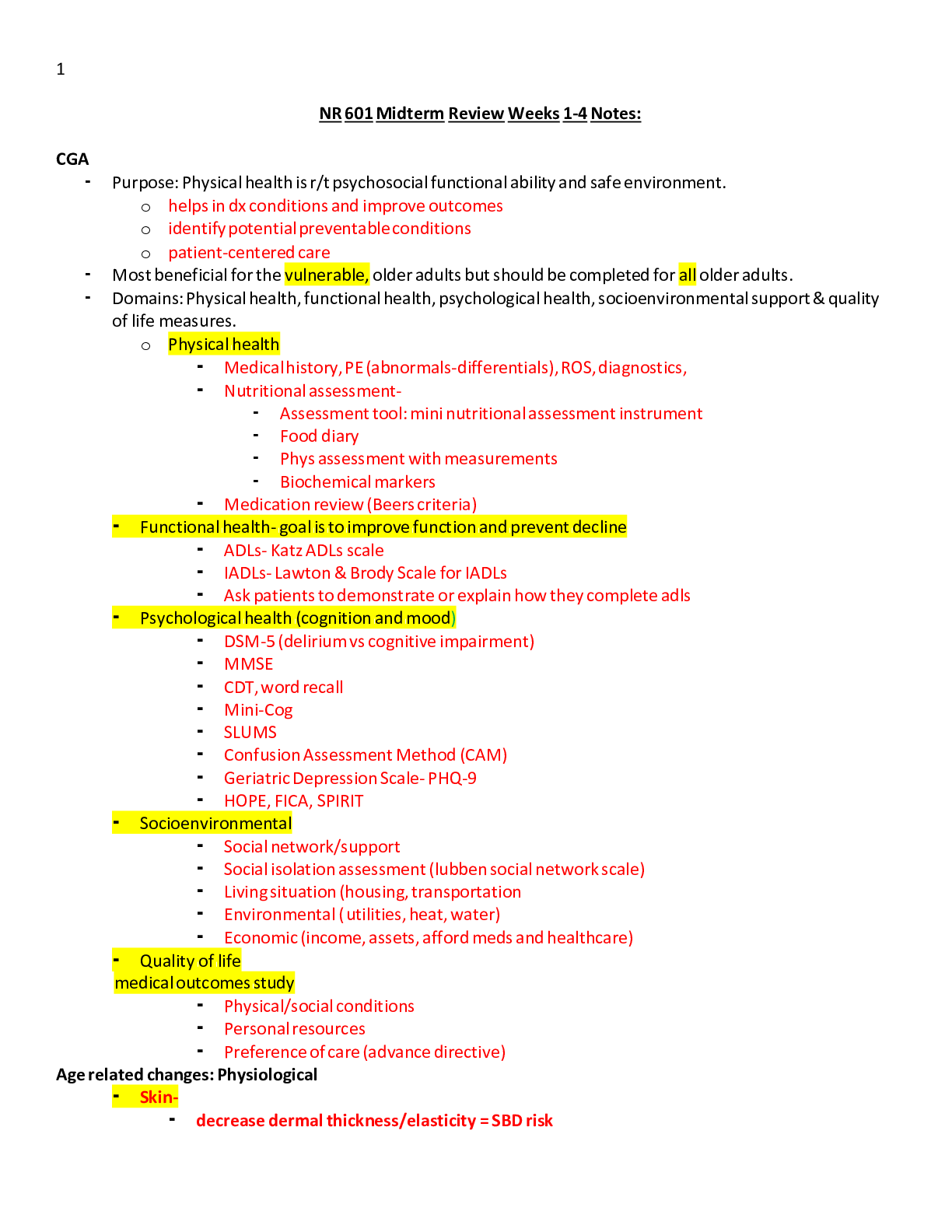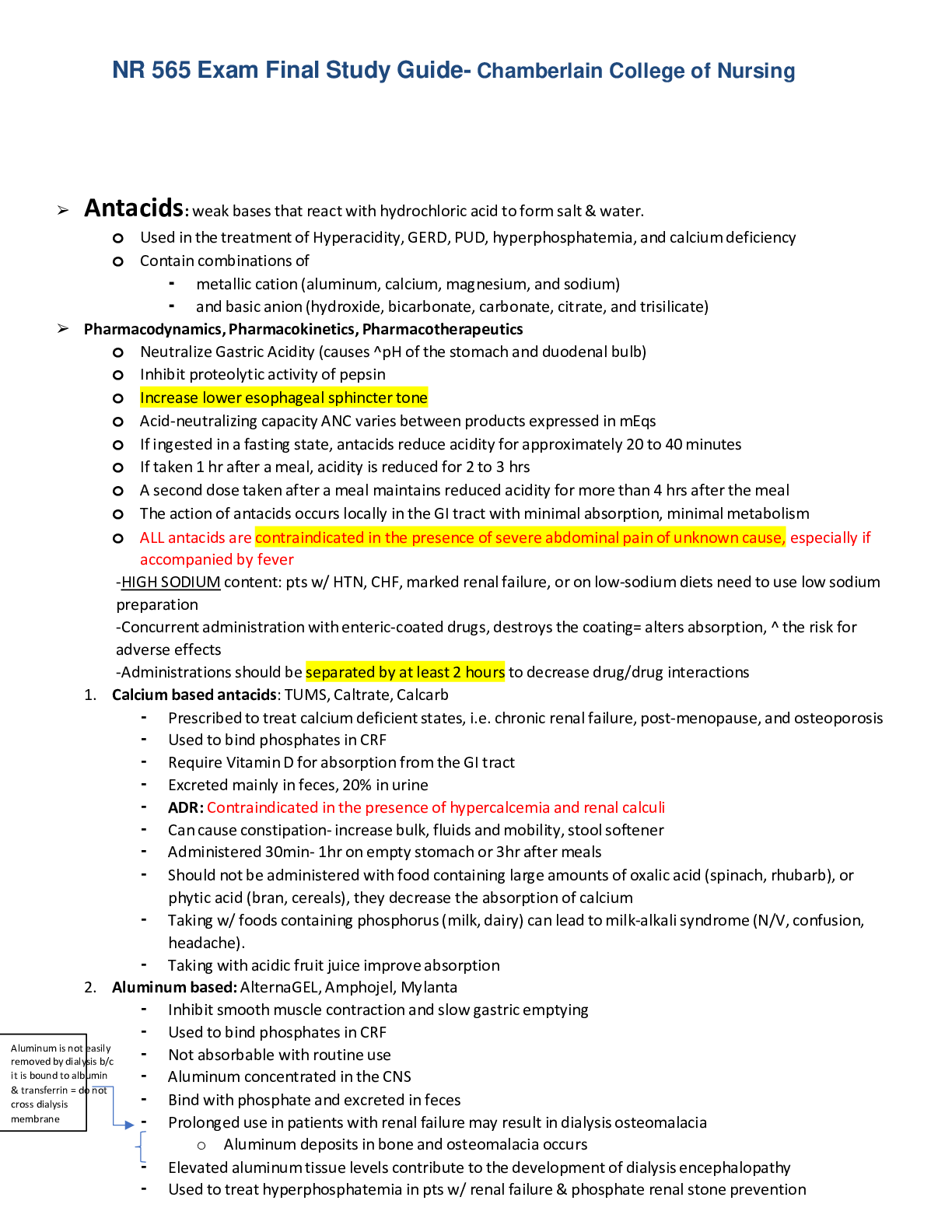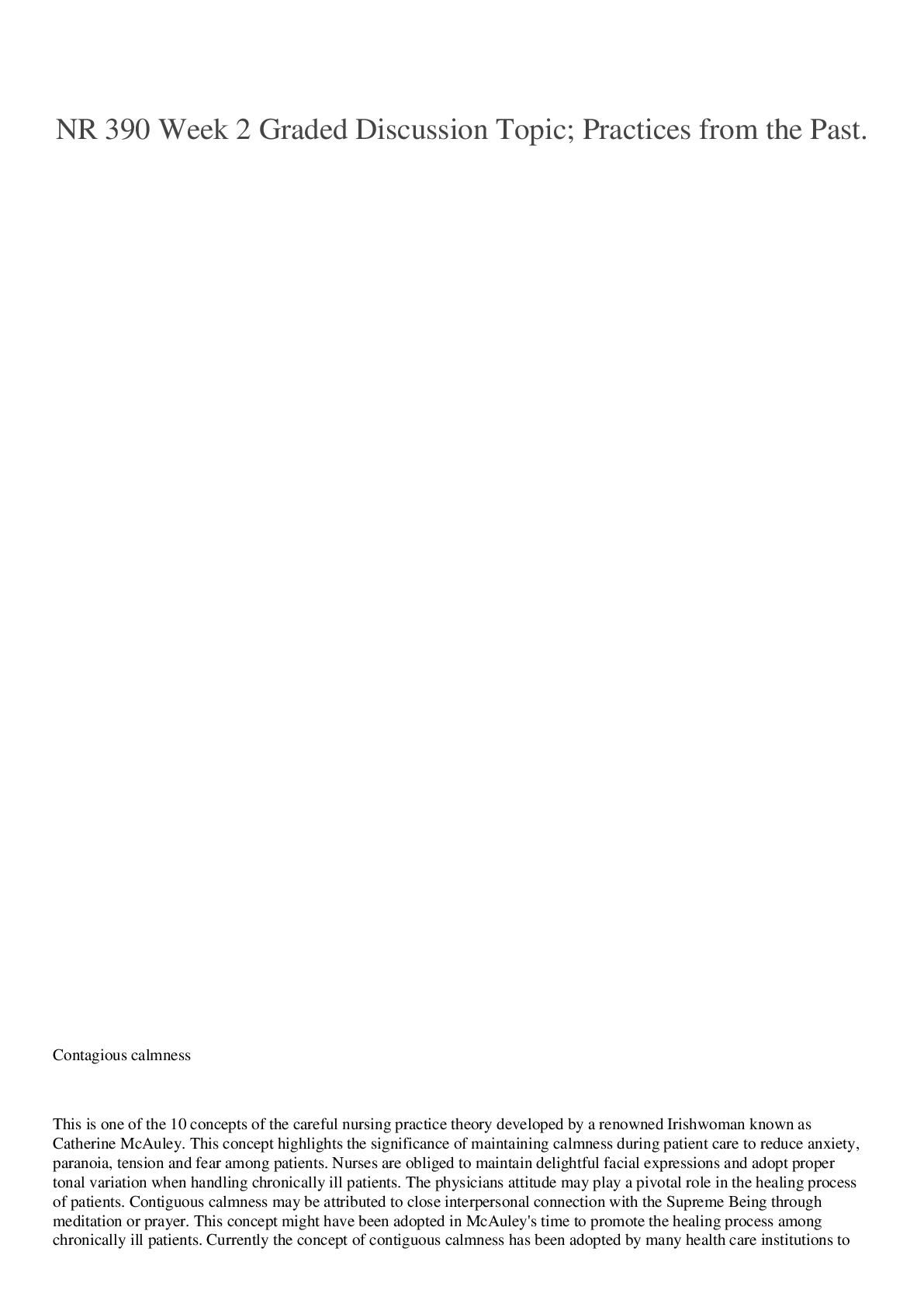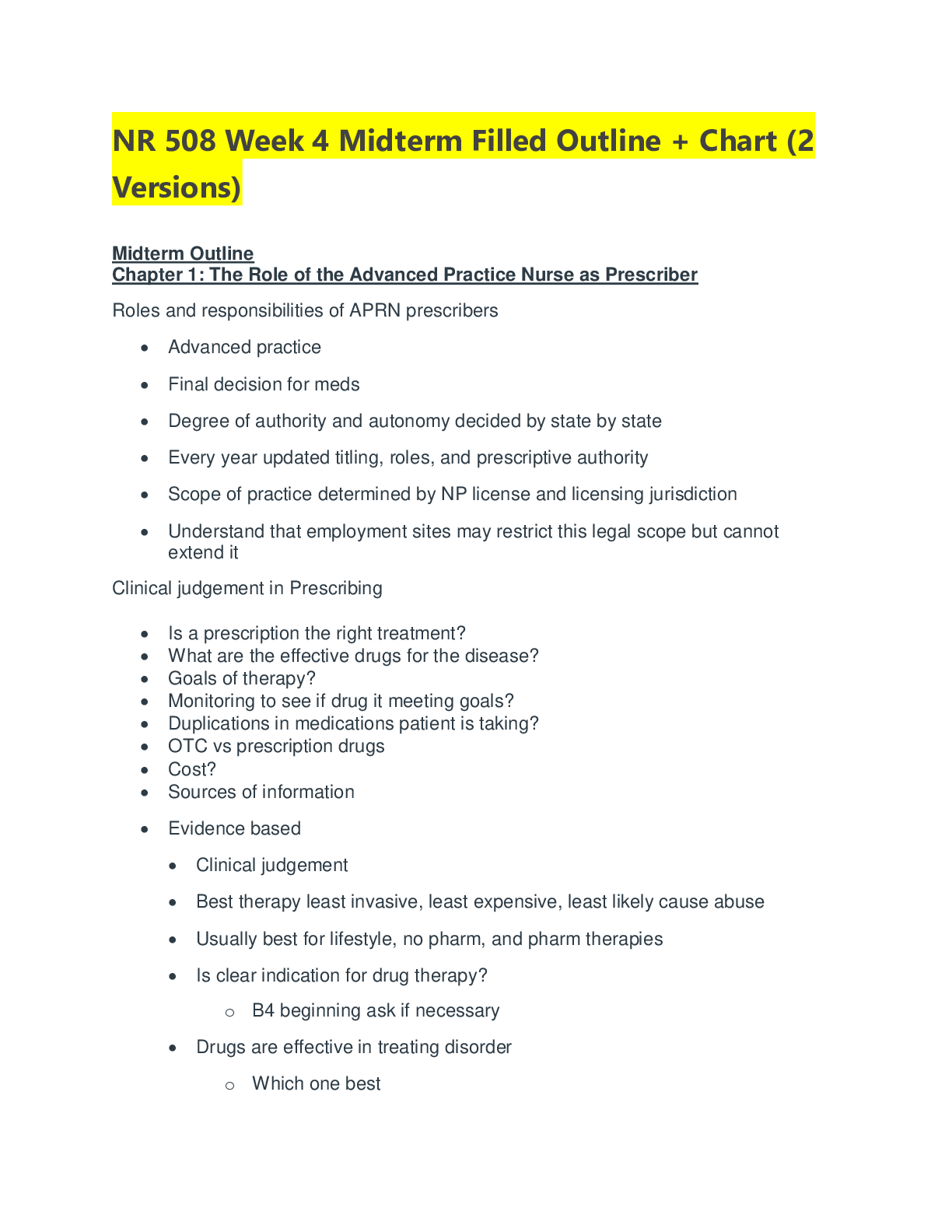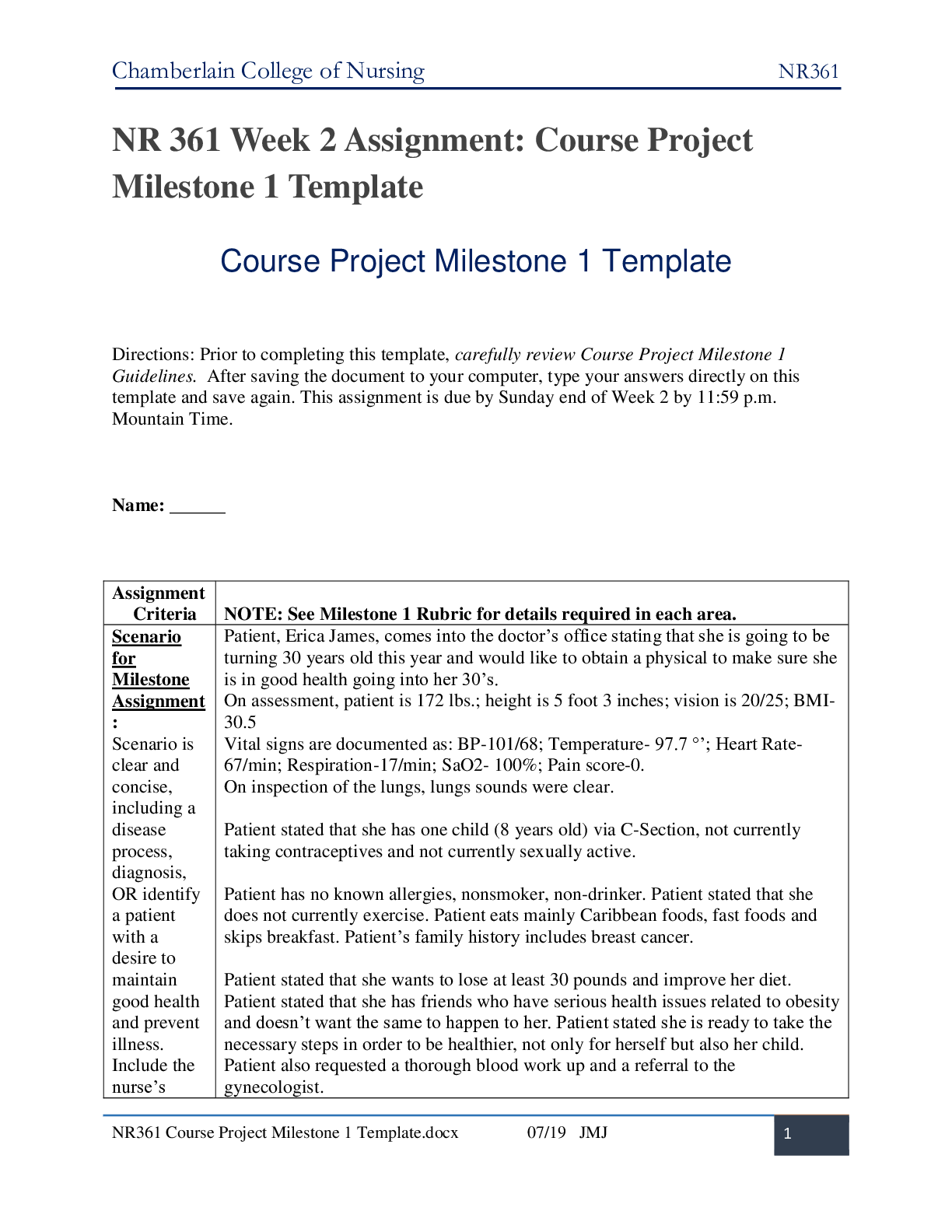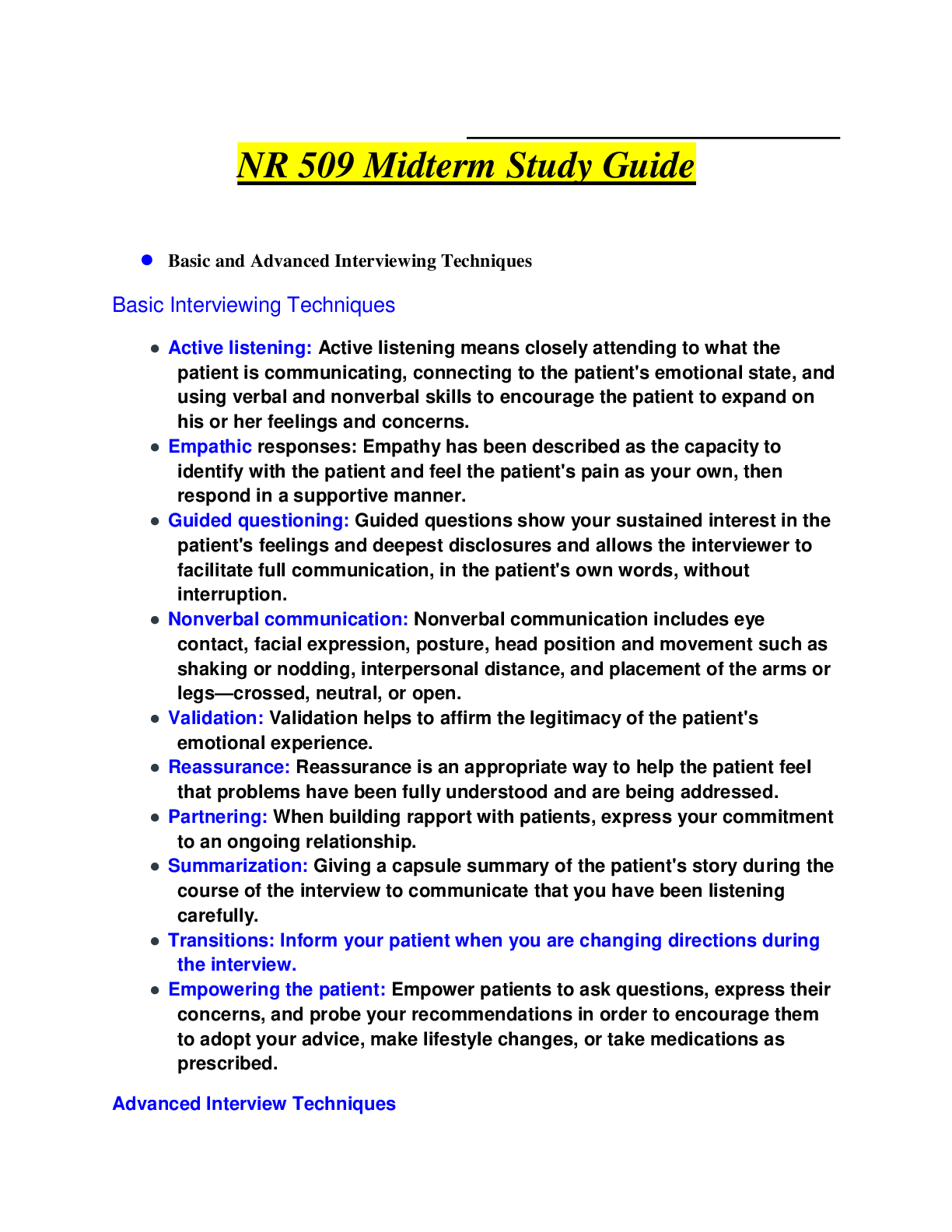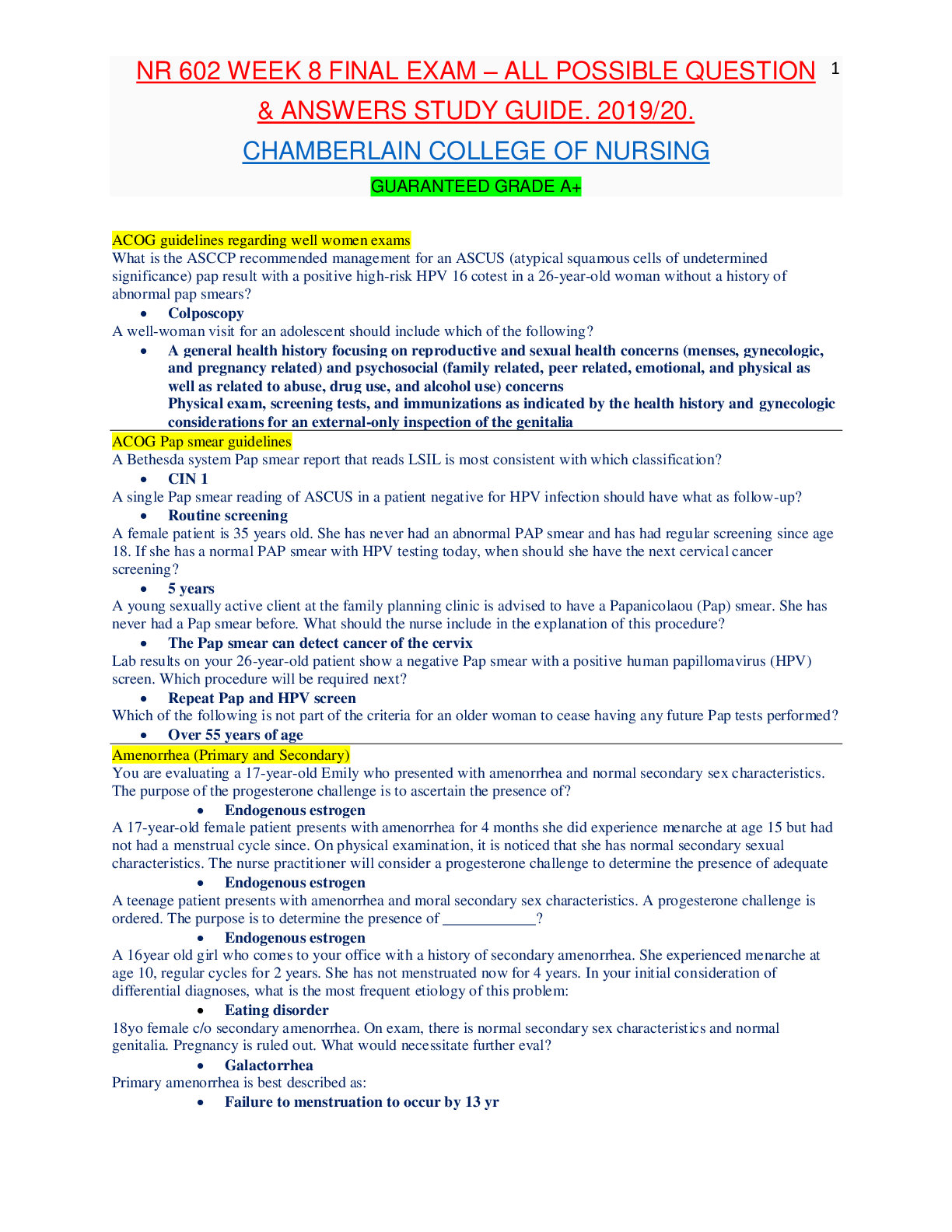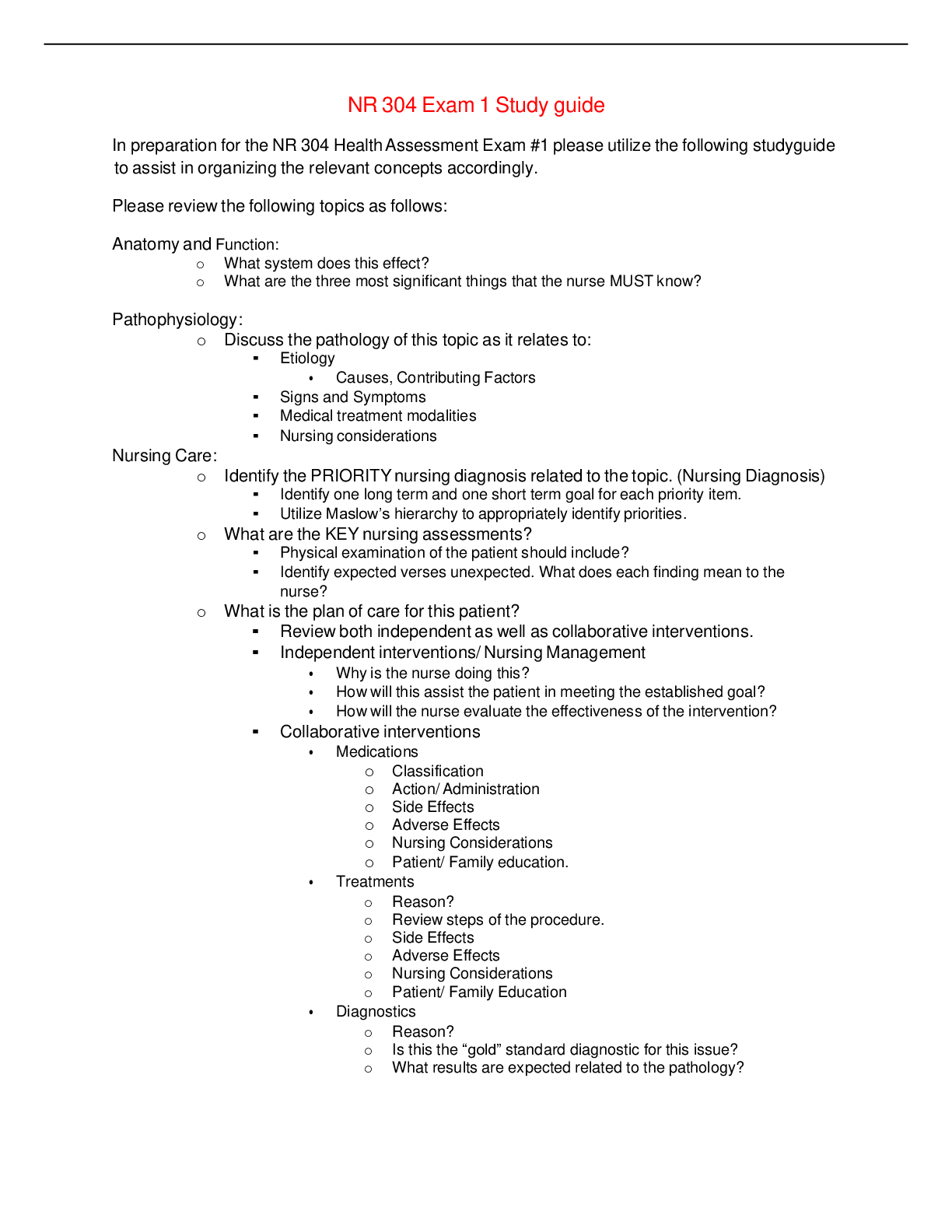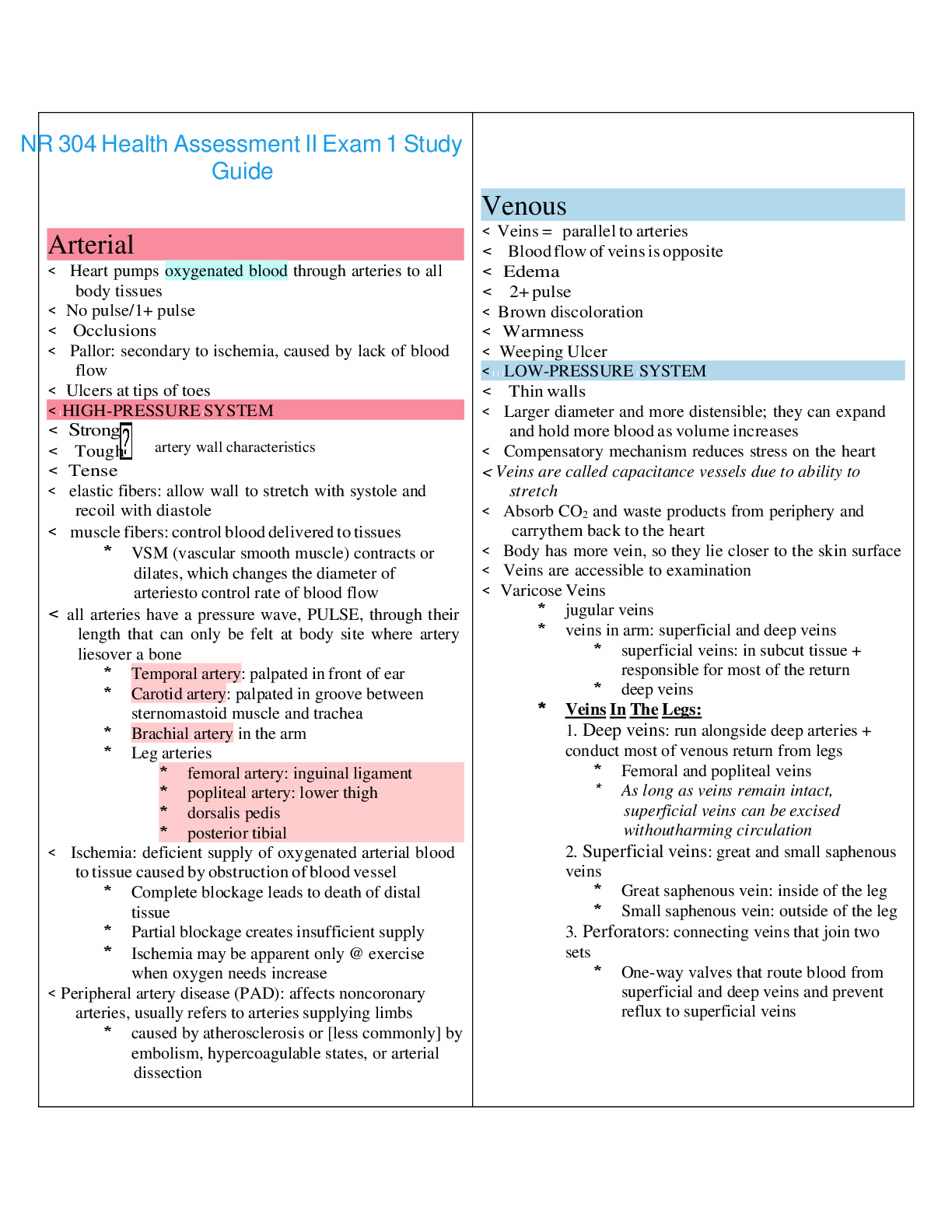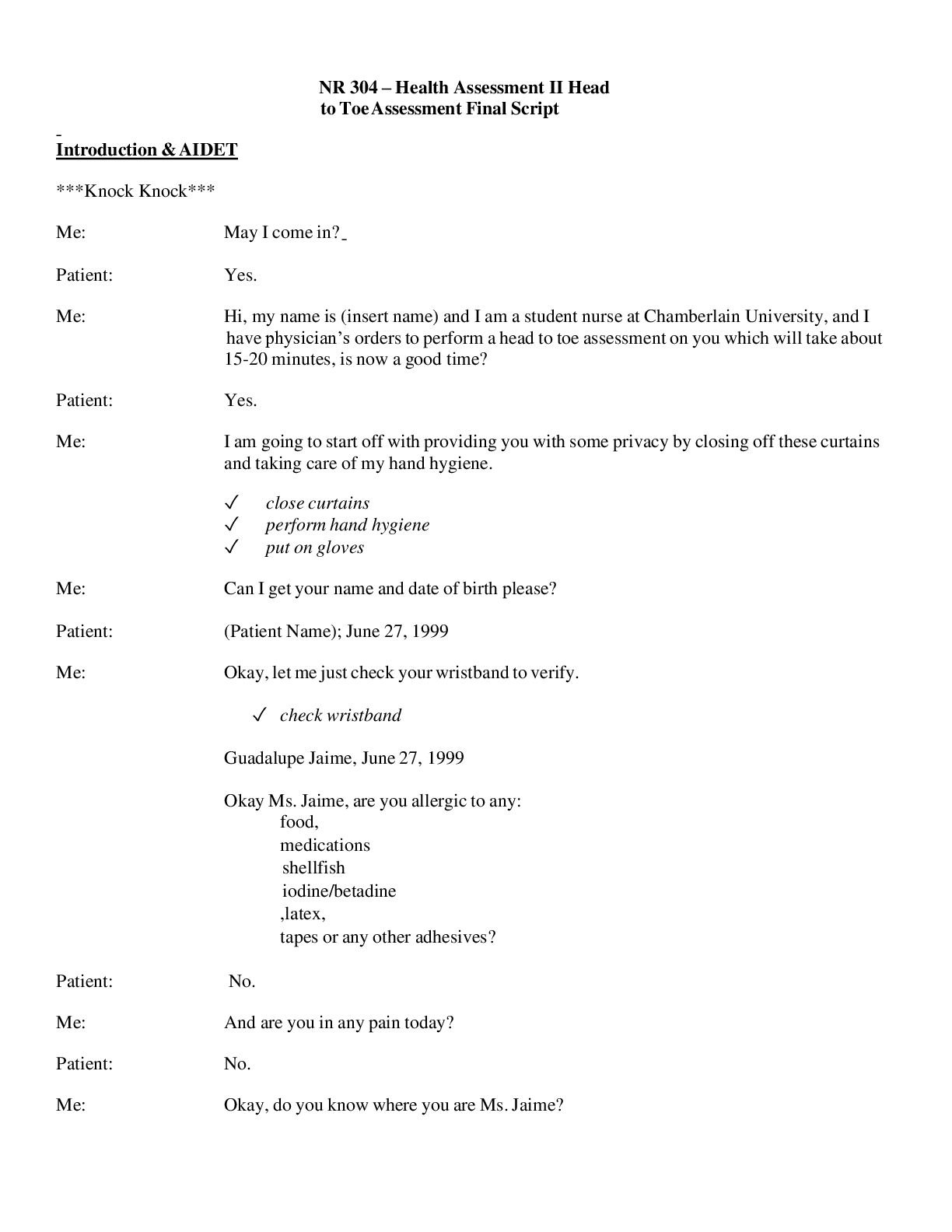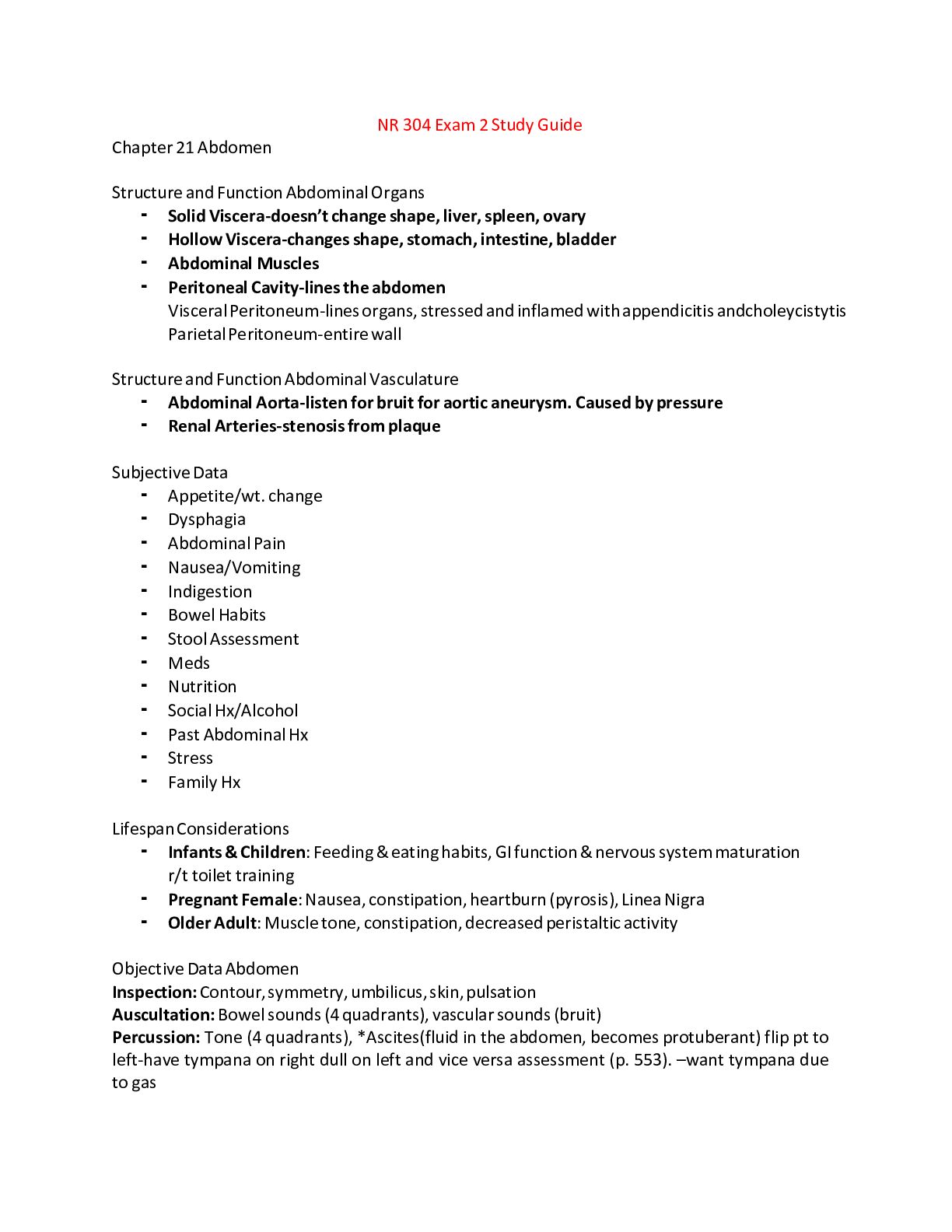*NURSING > STUDY GUIDE > NR 511 Completed Midterm study guide Worksheet. Chamberlain College of Nursing. (All)
NR 511 Completed Midterm study guide Worksheet. Chamberlain College of Nursing.
Document Content and Description Below
NR 511 Completed Midterm study guide | NR511 Midterm Study Guide Worksheet(2020) Complete A+ Guide;Chamberlain College of Nursing. Disease Risk Subjective Finding Objective Findings Diagnostics Treat... ment Education GI DISORDERS Appendicitis Celiac disease ** (autoimmune disorder caused by an immunologic response to gluten) Cholelithiasis Crohn’s ** Diverticulitis ** GERD ** Giardia H. Pylori Infection Irritable bowel syndrome ** Peptic ulcer disease ** (includes gastric ulcers and duodenal ulcers) Pancreatitis ACUTE\ CHRONIC Salmonella ** Shigella Ulcerative Colitis ** Viral gastroenteritis ** Bacterial conjunctivitis (viral is most contagious) Corneal abrasion Epiglotittis Eustachian tube disorder Hyphema (a layer of RBCs - hemorrhage) Meniere’s disease Mononucleosis: primarily caused by EBV Angie Nasal polyps Otitis Externa (AKA swimmer’s ear) ** Otitis Media Presbycusis (sensorineural hearing loss; not reversible) Rhinosinusitis - viral Rhinosinusitis - bacterial Streptococcus Tinnitus Viral conjunctivitis (highly contagious; usually caused by adenovirus which are associated with URIs or the common cold. Other viruses include HXV, HZV (zoster), and Molluscum contagiosum. 2 types of herpes viruses. HSV-1 typically occurs above the waist, and HSV-2 typically occurs below the waist. HSV conjunctivitis spread by contact with persons who have visible, infected lesions and with persons symptomatically shedding the virus. Meaning, the patient may be experiencing a prodrome of ill-related symptoms such as malaise, low grade fever, pain or tingling near site of the lesions (but the lesions are not yet visible). Allergic conjunctivitis is usually caused by an environmental allergen such as pollen, grass, trees, and so on. Occurrence can be seasonal and can be isolated to the eyes or include upper respiratory allergy symptoms such as rhinitis. Acanthosis nigricans: Benign dermatosis characterized by velvety, hyperpigmented, hyperkeratotic plaques Acne Actinic keratosis: Premalignant lesion that can progress to SCC. Alopecia areata, temporary loss of hair (nonscarring alopecia) Atopic dermatitis (eczema) is not considered a distinct entity but is a descriptive term for a group of skin disorders characterized by pruritus and inflammation whose distinct cause is unknown. Eczema is a more general term that is often used collectively to describe skin of an erythematous and inflamed appearance Basal Cell carcinoma (most common”): malignant tumor of the skin that originates in the basal cells of the epidermis. It is a slow-growing and locally invasive tumor that rarely metastasizes. Contact dermatitis: A common condition categorized as either irritant dermatitis or allergic dermatitis. Allergic dermatitis is from immunologically mediated response and irritant dermatitis is the result of repeated insults to atopic skin by caustic or irritant substances. Stages of contact dermatitis are: Acute: Erythema and edema Clear, fluid filled vesicles or bullae Exudate, clear fluid Distinct margins Subacute: Lessening edema Formation of papules Less distinct margins Chronic: Minimal edema Scaling skin Lichenification Minimal erythema Eczema Atopic dermatitis(eczema) is not considered a distinct entity but is a descriptive term for a group of skin disorders characterized by pruritus and inflammation whose distinct cause is unknown. Eczema is a more general term that is often used collectively to describe skin of an erythematous and inflamed appearance (SEE ATOPIC DERMATITS) Erythema infectiosum (AKA 5th disease or EI); primarily caused by human parvovirus B19 Erythema migrans (bull’s eye rash) associated with Lyme Disease Folliculitis: a superficial to deep skin infection of the hair follicles. Mainly caused by gram-positive bacteria, occasional by fungus or by gram-negative bacilli. Bacteria infect the hair follicle at a superficial level which leads to the clinical presentation of little pustules or erythema surrounding the base of the hair follicle. Pseudomonas folliculitis presents as follicular erythematous papules, pustules, or vesicles over the back, buttocks, and upper arms. Associated features include pruritus, malaise, low-grade fever, sore throat and eyes, and axillary lymphadenopathy. This type of folliculitis usually resolves spontaneously within 10 days. Shaving folliculitis is the result of sebaceous follicles which are colonized by gram negative bacteria become infected due to trauma from shaving. “Hot tub” folliculitis is a form of folliculitis that is caused by pseudomonas aeruginosa, which can withstand temperatures of up to 107 degrees F and chlorine levels up to 3mg/L. Hand Foot and Mouth Disease (HFMD) a contagious virus mostly occurring in young children which is caused by the coxsackievirus A16 and enterovirus 71. Keratosis pilaris – benign skin disorder resulting in hyperkeratinization of the hair follicles; Lichen Planus Jessica Sparks Melanoma Melasma Butterfly face Pregnancy mask Molluscum Contagiosum (viral infection that causes a mild skin rash, wart-like bump); caused by the Poxviridae virus. This virus is encased in a protective sac that prevents the immune system from being triggered. Pediculosis (head lice infestation) Pityriasis rosea Psoriasis Rosacea Roseola Infantum (AKA 6th disease) – caused by the human herpes virus types 6 and 7. Virus is mild and common in children under age 2; spread via saliva. Short lives 3-5 days Scabies Squamous Cell carcinoma: a malignant tumor originating from keratinocytes, can invade the dermis and occasionally metastasize to distant sites. Telogen Effluvium – can be a cause of non scarring alopecia. Is excessive shedding of scalp hair that results from an increases number of hair follicles entering the resting stage (telogen). Tinea versicolor (aka pityriasis versicolor) - Jenna Trichotillomania (hair pulling) - jenna Varicella Verruca vulgaris (Common warts): p.203 Small, hardened growths of keratinized tissue. Warts usually grow around nails, on fingers, and the backs of hands, but can appear anywhere on the body. Common warts (verruca vulgaris) are primarily caused by HPV serotypes 1 to 5, 7, 27, or 29, whereas HPV serotypes 3, 10, 28, and 29 cause flat warts. HPV serotypes 1 to 4, 27, 29, and 57 typically causes plantar warts, whereas HPV serotypes 6 and 11 cause anogenital warts. Vitiligo BUSINESS ESSENTIALS (jenna) Medical coding Medical billing CPT codes ICD10 codes Medicare Part A Medicare Part B Medicare Part D Health maintenance organization (HMO) (couldn’t find in text book) Preferred provider organization (PPO) (couldn’t find in text book) Indemnity insurer (couldn’t find in text book) Features Hepatitis A Virus (HAV) Hepatitis B Virus (HBV) Hepatitis C Virus (HCV) Hepatitis D Virus (HDV) Hepatitis E Virus (HEV) Transmission Incubation period (days) Laboratory tests Immunity/immunization Prevalence Course/mortality TABLE 15.2 Herpes Simplex Infections Infection Location Commonly Affected Age Group Oral—labial herpes simplex Herpetic keratoconjunctivitis Herpetic tracheobronchitis Herpes simplex encephalitis Herpes gladiatorum Herpetic whitlow Lumbosacral herpes Herpes simplex of the buttocks Genital herpes Eczema herpeticum Erythema multiforme Question 1. Treatment for achalasia may include: Balloon dilation of the lower esophageal sphincter. Question 2. Which oral medication might be used to treat a client with chronic cholelithiasis who is a poor candidate for surgery? Question 3. All of the following medications are used for the control of nausea and vomiting. Which medication works by affecting the chemoreceptor trigger zone, thereby stimulating upper gastrointestinal motility and increasing lower esophageal sphincter pressure? Question 4. Which is the most common presenting symptom of gastric cancer? Question 5. Margie, age 52, has an extremely stressful job and was just given a diagnosis of gastric ulcer. She tells you she is sure it is going to be malignant. How do you respond? Question 6. Marcie just returned from Central America with traveler’s diarrhea. Which is the best treatment? Question 7. Rose has gastroesophageal reflux disease (GERD). You know she misunderstands your teaching when she tells you she will: Have a snack before retiring so that the esophagus and stomach are not empty at bedtime. Question 8. Marty, age 52, notices a bulge in his midline every time he rises from bed in the morning. You tell him that it is a ventral hernia, also known as an: Question 9. You are trying to differentiate between functional (acquired) constipation and Hirschsprung disease in a neonate. Distinguishing features of Hirschsprung disease include which of the following? Question 10. You are doing routine teaching with a patient who has a family history of colorectal cancer. You know she misunderstands the teaching when she tells you she will: Question 11. Bobby, age 6, has constant periumbilical pain shifting to the right lower quadrant, vomiting, a small volume of diarrhea, absence of headache, a mild elevation of the white blood cell count with an early left shift, and white blood cells in the urine. You suspect: Question 12. Melva, age 63, presents with an acute exacerbation of pancreatitis, and you are going to admit her to the hospital. Which is the most important factor in determining a negative long-term outcome for her? Question 13. A mother brings in her 4-year-old child, who she states has acute abdominal pain and a rash. Which of the following do you initially rule out? Question 14. Icterus due to hyperbilirubinemia is seen when the serum level of bilirubin is greater than? 2.5 mg/dL. Question 15. A 45-year-old homeless man presents to your urgent care clinic for evaluation. His chief complaint is diarrhea. The patient states he started to have diarrhea 2-3 days ago, and it is getting progressively worse. He also notes nausea without vomiting, dry mouth, and double vision. On exam you notice his pupillary reflex is absent. The patient states he lives on the street and eats mostly canned goods that he scavenges from a grocery store dumpster. What is the likely cause of the patient’s symptoms? Question 16. Hepatitis D is an RNA virus that requires a coinfection with which of the following strains of hepatitis in Question 17. Which of the following is not true regarding hepatitis C? If hepatitis is asymptomatic it doesn’t cause cirrhosis or liver cancer. Question 18. A 54-year-old female presents to your primary care office for routine reevaluation for gastroesophageal reflux disease (GERD). She has been treated with diet modifications and 6 weeks of omeprazole without improvement of her symptoms. What is the next step in management of this patient’s GERD? Question 19. A 75-year-old male presents for a routine physical. He is obese and has no abdominal pain or recent injuries or problems. He has no complaints. He lies supine for his abdominal exam. He is nontender to palpation and has a normal exam. When he sits up you see a large mass protrude from his abdomen. It is central to his abdomen and inferior to his rib cage. It disappears when he is sitting up fully. What is the patient’s diagnosis? Question 20. Which gastrointestinal disease below could theoretically be completely eradicated with a total colectomy? Question 1. You auscultate Julie’s abdomen and hear a peritoneal friction rub. Which condition do you rule out? Question 2. Susan, age 59, has no specific complaints when she comes in for her annual examination. She does, however, have type 2 diabetes mellitus (DM), slight hypertension, dyslipidemia, and central obesity. How would you diagnose her? Question 3. Timothy, age 68, complains of an abrupt change in his defecation pattern. You evaluate him for: Question 4. Ruby has a colostomy and complains that her stools are too loose. What food(s) do you suggest to help thicken the stools? Cheese Question 5. Martina, age 34, has AIDS and currently suffers from diarrhea. You suspect she has which protozoal infection of the bowel? Question 6. When Sammy asks you what he can do to help his wife, who has dumping syndrome, what do you suggest he encourage her to do? Question 7. Lucy, age 49, has pain in both the left and right lower quadrants. What might you suspect? Question 8. You suspect appendicitis in Andrew, who is 18. With his right hip and knee flexed, you slowly rotate his right leg internally to stretch a muscle. He states that it is painful over his right lower quadrant. Which sign did you elicit? Rationales Option 1: Rovsing sign is pain elicited with deep palpation over the left lower quadrant (LLQ), with sudden resultant pain in the right lower quadrant (RLQ). Option 2: Psoas sign is pain elicited when the patient is instructed to try to lift the right leg against gentle pressure applied by the examiner or when the patient is placed in the left lateral decubitus position, extending the right leg at the hip. An increase in pain is considered positive and is an indication of the inflamed appendix irritating the psoas muscle. Option 3: Obturator sign is elicited when, with the patient’s right hip and knee flexed, the examiner slowly rotates the right leg internally, which stretches the obturator muscle. Pain over the right lower quadrant (RLQ) is considered a positive sign. Option 4: McBurney sign is pain elicited when pressure is applied to McBurney point, which is located halfway between the umbilicus and the anterior spine of the ilium. Question 9. You elicit costovertebral angle tenderness in Gordon, age 29. Which condition do you suspect? Question 10. Marvin, a known alcoholic with cirrhosis, is frequently admitted for coagulopathies and occasionally receives blood transfusions. His wife asks you why he has bleeding problems. How do you respond? Question 11. Olive has an acute exacerbation of Crohn’s disease. Which laboratory test value(s) would you expect to be decreased? Question 12. You suspect that Harry has a peptic ulcer and tell him that it has been found to be strongly associated with: Question 14. Dottie brings in her infant, who has gastroesophageal reflux. What do you tell her about positioning her infant? Question 15. To differentiate among the different diagnoses of inflammatory bowel diseases, you look at the client’s histological, culture, and radiological features. Mary has transmural inflammation, granulomas, focal involvement of the colon with some skipped areas, and sparing of the rectal mucosa. What do you suspect? Question 18. What is the best diagnostic test to confirm the diagnosis of celiac disease? Question 19. A 50-year-old female presents to the urgent care clinic complaining of left lower quadrant pain. She has associated nausea and vomiting, and her vital signs are as follows: temperature 102.5°F, pulse 110, blood pressure 150/90, pulse oximetry 99% on room air. What is the best test to evaluate this patient? Question 20. The screening guidelines for colon cancer recommend which of the following for the general population? Question 2. Zena just had a hemorrhoidectomy. You know she has not understood your teaching when she tells you she will: . Question 3. Simon, age 72, states that he is worried because he has a bowel movement only every third day. You respond: Question 4. Matt, age 26, recently returned from a camping trip and has gastroenteritis. He says that he has been eating only canned food. Which of the following pathogens do you suspect? Question 7. Anson tells you he thinks his antacids are causing his diarrhea. You respond: Question 9. Sandy, age 52, presents with jaundice, dark urine, and light-colored stools, stating that she is slightly improved over last week’s symptoms. Which stage of viral hepatitis do you suspect? Question 10. Ellie, age 42, has a seizure disorder and has been taking phenytoin (Dilantin) for years. Which supplement should she also be taking if no other problems exist? Question 13. Harvey just came back from Mexico. Which pathogen do you suspect is responsible for his diarrhea? Question 14. Which of the following medications/drugs are not known to cause heartburn or dyspepsia? Question 17. A 25-year-old male presents complaining of hematochezia. The patient states he has noticed this for 2 days. He states there is a streak of bright blood along his stool every time he has a bowel movement. The patient has no pain with his bowel movements. He admits to eating a poor diet. The patient has no abdominal pain, nausea, or vomiting. On physical exam the patient has a positive fecal occult blood test but has no noticeable rectal bleeding or lesions. What is the likely diagnosis? Question 20. Which of the following is the most common cause of acute pancreatitis? Question 1. The metabolism of which drug is not affected in Marsha, age 74? Question 2. Nausea is difficult to discern in a young child. What question might you ask to determine if a child has nausea? Question 3. Sally, age 21, is to undergo a tonsillectomy. She has heard about permanent taste changes after a tonsillectomy. What do you tell her? Question 7. Cydney has been given a diagnosis of ascariasis. Which symptoms would you expect to see? Question 8. Marian, age 52, is obese. She complains of a rapid onset of severe right upper quadrant abdominal cramping pain, nausea, and vomiting. Your differential diagnosis might be: Question 9. A 7-year-old male presents with his mother to the urgent care clinic complaining of abdominal pain. He started to complain of pain prior to going to bed; however, it has gotten progressively worse and is now preventing him from sleeping. He is nauseous but hasn’t vomited and didn’t eat dinner due to the pain. The patient appears pale and is complaining of right-sided abdominal pain. His vitals are as follows: blood pressure 130/85, pulse 120, temperature 100.5°F, pulse oximetry 98% on room air. On physical exam he is tender in the right lower quadrant. His complete blood count (CBC) shows a white blood cell count (WBC) of 17.0. What is the patient’s likely diagnosis? Question 10. What would you expect to see on an abdominal series that would lead toward a diagnosis of small-bowel obstruction? Question 2. What is the most common bacterial pathogen associated with acute otitis media? Question 4. When the Weber test is performed with a tuning fork to assess hearing and there is no lateralization, the nurse practitioner should document this finding as: Question 6. You are assessing a first grader and find that the tonsils are touching the uvula. How would you grade this finding? Question 1. Which of the following is not a cause of conductive hearing loss? Question 2. Jill, a 34-year-old bank teller, presents with symptoms of hay fever. She complains of nasal congestion, runny nose with clear mucus, and itchy nose and eyes. On physical assessment, you observe that she has pale nasal turbinates. What is your diagnosis? 1. Question 3. Mrs. Johnson, a 54-year-old accountant, presents to the office with a painful red eye without discharge. You should suspect: Question 4. April, age 50, presents with soft, raised, yellow plaques on her eyelids at the inner canthi. She is concerned that they may be cancerous skin lesions. You tell her that they are probably: Question 5. A 62-year-old woman presents to your clinic with a sudden right-sided headache that is worse in her right eye. She states that her vision seems blurred, and her right pupil is dilated and slow to react. The right conjunctiva is markedly injected, and the eyeball is firm. You screen her vision and find that she is 20/30 OS and 20/30 OD. She most likely has: 2. Rationales Option 1: With open-angle glaucoma, the onset is more insidious. Option 2: In angle-closure glaucoma, the patient presents with a sudden onset of symptoms as described in this case. This client has a visual deficit and pain as well as fullness of the affected eye. This is a medical emergency, and she should be referred immediately because, without intervention, blindness can occur within days. Option 3: Herpetic conjunctivitis is generally associated with a herpetic rash, and the pain is dull in character. Option 4: Diabetic retinopathy is a complication of diabetes that affects both eyes. It is caused by damage to the blood vessels of the light-sensitive tissue at the back of the eye (ie, the retina). Question 1. A 25-year-old male presents with “bleeding in my eye” for 1 day. He awoke this morning with a dark area of redness in his eye. He has no visual loss or changes. He denies constitutional symptoms, pruritus, drainage, or recent trauma. The redness presents on physical exam as a dark red area in the patient’s sclera of the right eye only and takes up less than 50% of the eye. The patient’s remaining sclera is clear and white. He also notes he was drinking alcohol last night and vomited afterward. What is the best treatment? Rationales Option 1: This would be the treatment for an infectious process; however, topical steroids need to be used in the eye with care. Option 2: This would be the treatment for a globe rupture or acute angle-closure glaucoma. Option 3: This is the classic presentation of a subconjunctival hemorrhage. It will resolve without treatment in 2 to 4 weeks. Vomiting probably caused his hemorrhage. Option 4: This is the treatment for viral conjunctivitis. Question 2. You prescribe Levaquin (levofloxacin) for a severe sinus infection. What is not a possible adverse reaction to this medication? Question 3. A 20-year-old male presents to your primary care clinic. This patient is a college student. He complains of fatigue, sore throat, and low-grade fever for 3 days. On physical exam, he has a temperature of 100.7°F. His ear exam is normal. His nose and throat exam shows mild erythema of the nasal mucosa and edematous, enlarged tonsils bilaterally, with erythema of the pharyngeal wall and tonsillar exudates. He has inflamed posterior cervical lymph nodes. He has a mild nonproductive cough and clear lung exam. What is his most likely diagnosis? Rationales Option 1: This presentation could be a viral pharyngitis; however, with posterior cervical lymphadenitis, you would suspect mononucleosis. Option 2: This presentation could be a viral pharyngitis; however, with posterior cervical lymphadenitis, you would suspect mononucleosis. Option 3: You would expect fever and tonsillar exudates without posterior cervical lymphadenitis. Option 4: Upper respiratory infections usually present with cough that may be productive and milder ear, nose, and throat symptoms. Question 4. When you are assessing the internal structure of the eye of your 59-year-old patient, the absence of a red reflex may indicate: Rationales Option 1: When assessing the internal structure of the eye, absence of a red reflex may indicate the total opacity of the pupil because of a cataract or hemorrhage into the vitreous humor. It may also be a result of improper positioning of the ophthalmoscope. Option 2: Acute iritis is noted by constriction of the pupil accompanied by pain and circumcorneal redness (ciliary flush). Option 3: The absence of a red reflex is not a normal finding. It may be caused by a cataract or a hemorrhage into the vitreous humor. Option 4: If areas of hemorrhage, exudate, and white patches are present when the internal structure of the eye is assessed, they are usually a result of diabetes or long-standing hypertension. Question 5. What significant finding(s) in a 3-year-old child with otitis media with effusion would prompt more There is a change in the child’s hearing threshold to greater than 25 dB. Rationales Option 1: If a child with otitis media with effusion has a change in the hearing threshold greater than 25 dB and has notable speech and language delays, more aggressive treatment is indicated. When the child’s hearing examination reveals a change in the hearing threshold, it is extremely important that the provider evaluate the child’s achievement of developmental milestones in speech and language. Any abnormal findings warrant referral. Option 2: A child with otitis media with effusion might become irritable during meals. Option 3: A slight delay in language and speech does not warrant aggressive treatment or referral. Option 4: Persistent rhinitis does not warrant aggressive treatment or referral. Question 6. Max, age 35, states that he thinks he has an ear infection because he just flew back from a business trip and feels unusual pressure in his ear. You diagnose barotrauma. What is your next action? Prescribe nasal steroids and oral decongestants. Question 7. Susan is a 19-year-old college student and avid swimmer. She frequently gets swimmer’s ear and asks if there is anything she can do to help prevent it other than wearing earplugs, which do not really work for her. What do you suggest? Start using a cotton-tipped applicator to dry the ears after swimming. Use ear drops made of a solution of equal parts alcohol and vinegar in each ear after swimming. Rationales Option 1: The adage “You shouldn’t put anything smaller than your elbow in your ear” holds true today. Option 2: Using ear drops made of a solution of equal parts alcohol and vinegar in each ear after swimming is effective in drying the ear canal and maintaining an acidic environment, therefore preventing a favorable medium for the growth of bacteria, the cause of swimmer’s ear. Option 3: A hair dryer operated on the lowest setting several inches from the ear may be used to dry the canal. Option 4: There is no reason for the client to stop swimming. Question 8. Mary, age 82, presents with several eye problems. She states that her eyes are always dry and look “sunken in.” What do you suspect? Normal age-related changes. Rationales Option 1: With hyperthyroidism, the eyes appear to bulge out (exophthalmos), but in hypothyroidism, the eyes do not appear any different. Option 2: Dryness of the eyes and the appearance of “sunken” eyes are normal age-related changes. Option 3: A moon face is apparent with Cushing syndrome, and this might make the eyes appear to be sunken in, although on close examination, they are not. Option 4: With a detached retina, the outward appearance is normal, but the client complains of seeing floaters or spots in the visual field and describes the sensation as like a curtain being drawn across the vision. Question 9. Nystatin (Mycostatin) is ordered for Michael, a 56-year-old banker who has an oral fungal infection. What instructions for taking the medication do you give Michael? “Swish and swallow the medication.” Rationales Option 1: The oral medication should not be diluted, as that may compromise the absorption. Option 2: Taking the medication with meals may compromise the absorption. Option 3: When ordering nystatin (Mycostatin) for an oral fungal infection, tell the client to swish the medication in the mouth to coat all the lesions and then to swallow it. Option 4: It is almost impossible to apply this liquid medication to only the lesions; swishing it in the mouth coats all the lesions more effectively. Question 10. The most common cause of a white pupil (leukokoria or leukocoria) in a newborn is: A congenital cataract. Rationales Option 1: The most common cause of a white pupil (leukokoria or leukocoria) in a newborn is a congenital cataract. The incidence may be as high as 1 in every 500 to 1000 live births, and there is usually a family history. Some infants require no treatment; however, in other cases surgery may be performed during the first few weeks of life. Option 2: Retinoblastoma, a common intraocular malignancy, is detected within the first few weeks of life and is the second most common cause of a white pupil. Option 3: Persistent hyperplastic primary vitreous is the third most common cause of a white pupil and is a congenital developmental abnormality. Option 4: Retinal detachment may occur as a result of trauma or disease and only rarely occurs in infancy. Question 11. You diagnose acute epiglottitis in Sally, age 5, and immediately send her to the local emergency room. Which of the following symptoms would indicate that an airway obstruction is imminent? Question 12. A 27-year-old female comes in to your primary care office complaining of a perioral rash. The patient noticed burning around her lips a couple days ago that quickly went away. She awoke from sleep yesterday and noticed a group of vesicles with erythematous bases where the burning had been before. There is no burning today. She is afebrile and has no difficulty eating or swallowing. What test would confirm her diagnosis? Question 13. Which condition is not included in the atopic triad? Question 14. The ABCDEs of melanoma identification include which of the following? Question 15. Your 24-year-old client whose varicella rash just erupted yesterday asks you when she can go back to work. What do you tell her? Question 16. Tom, age 50, is complaining of an itchy rash that occurred about a half hour after putting on his leather jacket. He recalls having a slightly similar rash last year when he wore his jacket. The annular lesions are on his neck and both arms. They are erythematous, sharply circumscribed, and both flat and elevated. His voice seems a little raspy, although he states that his breathing is normal. What is your first action? Question 17. You suspect a platelet abnormality in a 40-year-old woman who presents to your clinic with: Question 18. Justin, an obese 42-year-old, cut his right leg 3 days ago while climbing a ladder. Today his right lower leg is warm, reddened, and painful, without a sharply demarcated border. What do you suspect? Question 19. During a camping trip, Jim, age 35, abruptly developed fever, headache, and joint pain. A few days after the onset of the fever, a blanchable macular rash began on his wrists and ankles and quickly spread to the palms and soles before becoming generalized. The rash is now petechial. You suspect Jim has: Question 20. You’re teaching Mitch, age 18, about his tinea pedis. You know he doesn’t understand your directions when he tells you which of the following? Question 1. A 75-year-old female presents to your office complaining of dizziness and hearing loss. The patient states she awoke yesterday with dizziness, which she described as feeling the room spinning. She also notes intermittent ringing in her ears. On physical exam, the patient has lateralization of her hearing loss to the unaffected ear. Rinne test shows air conduction lasts longer than bone conduction. What is the next step in helping this patient’s symptoms? Question 3. Which of the following is not recommended for hoarseness? Question 4. Kevin, a 56-year-old lawyer, has throbbing pain in the left eye, an irregular pupil shape, marked photophobia, and redness around the iris. What is your initial diagnosis? Question 5. You are the nurse practitioner caring for Martha, a 47-year-old accountant. You have made a diagnosis of acute sinusitis based on Martha’s history and the fact that she complains of pain behind her eye. Which sinuses are affected? 2. Question 6. Marlene, a 57-year-old cashier, comes to the clinic because she is unable to differentiate between sharp and dull stimulation on both sides of her face. You suspect: Question 7. While doing a face, head, and neck examination on a 16-year-old patient, you note that the palpebral fissures are abnormally narrow. What are you examining? Question 8. A 44-year-old banker comes to your office for evaluation of a pulsating headache over the left temporal region, and he rates the pain as an 8 on a scale of 1 to 10. The pain has been constant for the past several hours and is accompanied by nausea and sensitivity to light. He has had frequent, though less severe, headaches for many years, and they are usually relieved by over-the-counter medicines. He is unclear as to a precipitating event but notes that he has had visual disturbances before each headache and he has been under a lot of stress in his job. Based on this description, what is the most likely diagnosis of this type of headache? Question 9. Your client, a 72-year-old smoker of 50 years, is at the office today for a routine physical. During your inspection of the oral mucosa, you discover a white lesion on the lateral surface of the tongue that you suspect to be cancerous. You document your finding as: Question 10. Which of the following conditions produces sharp, piercing facial pain that lasts for seconds to minutes? Question 11. Mary, age 82, presents with several eye problems. She states that her eyes are always dry and look “sunken in.” What do you suspect? Question 12. A 64-year-old obese woman comes in complaining of difficulty swallowing for the past 3 weeks. She states that “some foods get stuck” and she has been having “heartburn” at night when she lies down, especially if she has had a heavy meal. Occasionally, she awakes at night coughing. She denies weight gain and/or weight loss, vomiting, or change in bowel movements or color of stools. She denies alcohol and tobacco use. There is no pertinent family history or findings on review of systems (ROS). Physical examination is normal, with no abdominal tenderness, and the stool is occult blood (OB) negative. What is the most likely diagnosis? Question 13. Mr. Johnson, age 69, has had Meniere disease for several years. He has some hearing loss but now has persistent vertigo. What treatment might be instituted to relieve the vertigo? Question 14. Marjorie, age 37, has asthma and has been told she has nasal polyps. What do you tell her about them? 2. Cataracts are a common occurrence in patients over 60 years of age. You counsel your patient that the best cure for cataracts is: Corrective lens surgery. In a young child, unilateral purulent rhinitis is most often caused by: Kathleen, age 54, has persistent pruritus of the external auditory canal. External otitis and dermatological conditions, such as seborrheic dermatitis and psoriasis, have been ruled out. What can you advise her to do? Question 19. At the clinic, you are assessing Kyle, a 4-month-old baby, for the first time and notice that both eyes are turning inward. What is this called? Question 20. Kevin, age 26, has AIDS and presents to the clinic with complaints of a painful tongue covered with what look like creamy white, curdlike patches overlying erythematous mucosa. You are able to scrape off these “curds” with a tongue depressor, which assists you in making which of the following diagnoses? Which of the following patients would not be at risk of Candida infection? 1. Which of the following has/have not been linked to the use of isotretinoin? Sophie brings in her husband, Nathan, age 72, who is in a wheelchair. On his sacral area, he has a deep crater with full-thickness skin loss. Subcutaneous tissue is visible but muscle and bone are not. Which pressure ulcer stage is this? A Gram stain of a lesion reveals large, square-ended, gram-positive rods that grow easily on blood agar. Which diagnosis does this finding confirm? Question 6. Roy, age 13, was recently diagnosed with epilepsy and prescribed carbamazepine for control of his seizures. He has developed erythematous papules, dusky appearing vesicles, purpura, and target lesions that have erupted rapidly and are more centrally distributed on the face. He has hemorrhagic crusts on his lips. He tells you his skin feels tender and burns. Additionally, he has developed exudative conjunctivitis. These findings are indicative of: Question 8 Which disease usually starts on the cheeks and spreads to the arms and trunk? Erythema infectiosum (fifth disease). Jennifer, age 32, is pregnant and has genital warts (condylomata) and would like to have them treated. What should you order? Question 9 Louis, age 52, presents with pruritus with no rash present. He has hypertension, diabetes, and end-stage renal disease (ESRD). Which of the following would be included in the differential diagnosis? Question 10 Susan states that her fiancé has been frostbitten on the nose while skiing and is fearful that it will happen again. What do you tell her? Question 11 What is the most important thing a person can do to maintain healthy skin and hopefully reduce wrinkles? Question 12 Which of the following statements about malignant melanomas is true? Lee brings her 13-year-old son to your clinic. He has been complaining of a rash on the buttocks, anterior thighs, and posterolateral aspects of his upper arms. He tells you it is mildly pruritic and looks like “gooseflesh.” On examination, the rash appears as small, pinpoint, follicular papules on a mildly erythematous base. You explain to Lee that the benign condition is likely to resolve by the time her son reaches adulthood, and it is known as: Question 14. Jim, age 59, presents with recurrent, sharply circumscribed red papules and plaques with powdery white scale on the extensor aspects of his elbows and knees. What do you suspect? Question 15. Mildred, age 72, presents to the clinic with a blistering rash that is generalized but located mostly in skin folds and on flexural areas. She describes the course of the rash as beginning with pruritic urticarial papules that coalesced into plaques that turned dark red in about 2 weeks, followed by the development of vesicles and bullae. She tells you that the lesions are moderate to severely pruritic. During your exam, you determine the bullae are very tense and do not rupture when pressure is applied. Her daily medications include an angiotensin-converting enzyme (ACE) inhibitor, a loop diuretic, and a nonsteroidal anti-inflammatory drug (NSAID). What is your diagnosis? Question 16. Sandra, age 69, is complaining of dry skin. What do you advise her to do? Question 17. Caroline has a 13-year-old daughter who has had 2 recent infestations of lice. She asks you what she can do to prevent this. You respond: Question 18. Candidiasis may occur in many parts of the body. James, age 29, has it in the glans of his penis. What is your diagnosis? Question 19. Mr. Swanson, age 67, presents to the clinic for his annual health exam. He asks you if there is anything he can do to prevent the painful, blistering sores that develop on his lip in the summertime when he plays golf. You explain to Mr. Swanson that the way to prevent the development of these lesions is to: Question 20. A biopsy of a small, yellow-orange papulonodule on the eyelid will probably show: Question 1. A 75-year-old African American male presents to your family practice office complaining of visual impairment. He has worn corrective lenses for many years but has noticed that his vision has gotten progressively worse the past 6 months. He denies pain. He states his vision is worse in both eyes in the peripheral aspects of his visual field. He also notes trouble driving at night and halos around street lights at night. You test his intraocular pressure, and it is 23 mm Hg. What is his most likely diagnosis? Question 2. Which of the following is not a complication of untreated group A streptococcal pharyngitis? Question 3. The antibiotic of choice for recurrent acute otitis media (AOM) and/or treatment failure in children is: Question 4. Mattie, age 64, presents with blurred vision in 1 eye and states that it felt like “a curtain came down over my eye.” She doesn’t have any pain or redness. What do you suspect? Question 5. While doing a face, head, and neck examination on a 16-year-old patient, you note that the palpebral fissures are abnormally narrow. What are you examining? Question 6. Mia, a 27-year-old school teacher, has a 2-day history of severe left ear pain that began after 1 week of upper respiratory infection (URI) symptoms. On physical examination, you find that she has acute otitis media (AOM). She has a severe allergy to penicillin. The most appropriate antimicrobial option for this patient is: Question 7. Mario, a 17-year-old high school student, came to the office for evaluation. He is complaining of persistent sore throat, fever, and malaise not relieved by the penicillin therapy prescribed recently at the urgent care center. As the nurse practitioner, what would you order next? Question 8. Cynthia, a 31-year-old woman with a history of depression, is seen in the office today for complaints of headaches. She was recently promoted at her job, and this has caused increased stress. She describes the headache as a tightening (viselike) feeling in the temporal and nuchal areas. The pain is bilateral and tends to wax and wane. It started approximately 2 days ago and is still present. What kind of headache is she describing? Question 9. Ellen, a 56-year-old social worker, is seen by the nurse practitioner for complaints of fever; left-sided facial pain; moderate amounts of purulent, malodorous nasal discharge; and pain and headache when bending forward. The symptoms have been occurring for approximately 6 days. On physical assessment, there is marked redness and swelling of the nasal passages and tenderness/pain on palpation over the cheekbones. The nurse practitioner should suspect: Question 10. Sally, age 19, presents with pain and pressure over her cheeks and discolored nasal discharge. You cannot transilluminate the sinuses. You suspect which sinus to be affected? Question 11. A 3-year-old patient presents to your pediatric office with her mother. She has recently been started in day care. Her mother noted slight perioral erythema on the right side of the patient’s mouth prior to bed last night. The patient awoke today with 3 small, superficial, honey-colored vesicles where the erythema was last night. The patient has no surrounding erythema. She had no difficulty eating this morning and is active and energetic and doesn’t appear lethargic or fatigued. She is also afebrile. How would you treat this child? Question 12. Sandra, age 32, comes in to the clinic. She has painful joints and a distinctive rash in a butterfly distribution on her face. The rash has red papules and plaques with a fine scale. What do you suspect? Question 14. The nurse practitioner (NP) tells Samantha, age 52, that she has an acrochordon on her neck. What is the NP referring to? Question 17. Thomas, age 35, uses a high-potency corticosteroid cream for a dermatosis. He also currently has tinea corporis. You tell him the following regarding the cream: Question 19. A mother complains that her newborn infant, while lying on his side, appears red on the dependent side of the body and pale on the upper side. When she picks up the baby, this coloring disappears. You explain to her about which of the following? Question 20. Helen, age 39, comes to your clinic for generalized joint pain, especially in the knees and hands. She tells you that the pain is moderate, spreading, and symmetrical. She reports having had a sore throat and low-grade fever for a few days and then developing a rash, described as warm erythema of the cheeks, which lasted about 4 days before disappearing. You ask her if the rash on the cheeks included the nasolabial folds or circumoral skin, and she tells you that it did not cover these areas. Two days later, she developed a nonspecific macular eruption that preceded the joint pain. Her rash faded within 2 weeks, but she tells you that it comes and goes if she bathes in hot water or spends time in the sunlight. Your patient’s symptoms are most consistent with a diagnosis of: Question 1. Which of the following statements about macular degeneration is not true? Question 2. A 6-year-old female presents to your pediatric office with her mother complaining of right ear pain for 3 days. This pain resolved with Tylenol. The patient has also had noted fevers of 101.3°F over the last 2 nights. The patient had a nonproductive cough for 7 days prior to the ear pain. On physical exam, the patient has tenderness with tugging on the auricle of the ear. The tympanic membrane is not mobile with pneumatic otoscopy and is erythematous and full. The patient has no drainage from the ear and no mastoid tenderness. What is the next step? Question 3. What is the most common cause of epistaxis? Question 4. Mallory brings her 4-week-old infant to the office because she noticed small, yellow-white, glistening bumps on her infant’s gums. She says they look like teeth, but she is worried that they may be cancer. You diagnose these bumps as: Question 5. Jonathan, age 19, has just been given a diagnosis of mononucleosis. Which of the following statements is true? Question 6. Martin, age 24, presents to the office with an erythematous ear canal and pain on manipulation of the auricle. He is on vacation and has been swimming daily at the resort. What is your diagnosis? Question 7. Samantha, age 12, presents with ear pain. When you begin to assess her ear, you tug on her normal-appearing auricle, eliciting severe pain. This leads you to suspect: Question 8. Which manifestation is noted with carbon monoxide poisoning? Question 9. A 22-year-old African American female presents to your family practice office complaining of progressive skin discoloration. She is adopted and has no known family history of skin problems. The patient notes nonpalpable patches of skin loss and blanching of her forehead and both hands and feet. It has developed over a period of 6 months and appears to have stopped. It is not pruritic, and there is no erythema or sign of infectious etiology. What is the most likely diagnosis? Question 11. A 16-year-old male presents to your office. He was sent by an orthopedist. He has recently had surgical fixation of a humerus fracture. The patient has been going to physical therapy and has been developing a rash on his arm after therapy that disappears shortly after returning home. He does not have the rash prior to therapy. The patient denies fevers and chills, and his incision is well healed, with no signs of infection. Of note, the patient has been experiencing more hand edema than the average patient and has had edema wraps used at the end of therapy to help with his swelling. The wraps are made of a synthetic plastic material. The rash the patient gets is erythematous and blotchy, not raised; it is on the operative upper extremity. What is the most likely diagnosis? Question 13. Maryann, age 28, presents to the clinic because of a rapid onset of patchy hair loss. The skin within these oval patches of hair loss is very smooth. Tapered hairs that resemble exclamation points are seen at the margin of a patch of hair loss. Based on these findings, you suspect Maryann has: Question 14. Which treatment is considered the gold standard in tissue-conserving skin cancer removal? Question 15. You are examining Barbara, age 27, who presents with multiple dry, dusky red, well-localized plaques with a “stuck-on” appearance. They are 5 to 20 mm in diameter and located on her face, scalp, and external ears. You note there is atrophy, telangiectasia, depigmentation, and follicular plugging present. On examination of the scalp, there are areas of total hair loss. There is depigmented scarring of the concha of the ear. Your most likely diagnosis is: Question 16. Michael, a 25-year-old military reservist, presents to your clinic for a rash that began on his chest and has since developed into smaller lesions that are more concentrated on the lower abdomen and pubic area. In obtaining a history of the present illness, he reports that he had an upper respiratory infection 1 month before the rash developed. He tells you it started with 1 large oval-shaped lesion on his left chest, and 1 to 2 weeks later he developed numerous smaller lesions on the lower abdomen and groin. It has been 2 weeks since the smaller lesions developed, and he tells you he is concerned that the rash isn’t improving. As you examine the patient, you note that the lesions are salmon-colored and have a thin collarette of scale within them. The original lesion is still present. You suspect Michael has: Question 17. Shelby, age 14, has a blister on her arm that is filled with clear fluid. It is the result of contact with a hot iron. How do you document this? Question 18. Deanna, age 6, was bitten by a friend’s dog. Her mother asks you if the child needs antirabies treatment. You tell her: Question 19. Buddy, age 13, presents with annular lesions with scaly borders and central clearing on his trunk. What do you suspect? Question 20. Sandy asks what she can do for Dolores, her 90-year-old mother, who takes a bath every day and who has extremely dry skin. You respond: Question 6. Erica, age 39, has a sudden onset of shivering, sweating, headache, aching in the orbits, and general malaise and misery. Her temperature is 102°F. The nurse practitioner diagnosed her with influenza (flu). What is your next course of action? Question 7. You diagnose 46-year-old Mabel with viral conjunctivitis. Your treatment should include: Question 8. Which presentation is most concerning for skin cancer? Question 9. A 4-year-old male presents to your pediatric clinic with his mother complaining of an itchy rash, mostly between his fingers. This has been going on for multiple days and has been getting worse. The patient recently started at a new day care. On physical exam, the patient is afebrile and has multiple small (1-2 mm) red papules in sets of 3 located in the web spaces between his fingers. He also has signs of excoriation. What is the treatment for this problem? Question 10. Which of the following statements about psoriasis is not true? Question 11. Eric, age 52, has gout. What do you suggest? Question 12. Marge, age 36, is planning to go skiing with her fiancé. He has warned her about frostbite, and she is wondering what to do if frostbite should occur. You know she’s misunderstood the directions when she tells you which of the following? Question 13. Which disease usually starts on the cheeks and spreads to the arms and trunk? Question 15. A dark-field microscopic examination is used to diagnose: Question 16. Which of the following should be used with all acne medications? Question 18. In a burn trauma, which blood measurement rises as a secondary result of hemoconcentration when fluid shifts from the intravascular compartment? Question 2. Alexandra, age 34, was treated with oral antibiotics 2 weeks ago for a urinary tract infection. She is seen in the office today for a follow-up visit. On physical examination, the nurse practitioner notices that she has some painless, white, slightly raised patches in her mouth. This is probably caused by: Question 4. Aaron, age 4, is brought in to the clinic by his father. His tympanic membrane is perforated from otitis media. His father asks about repair of the eardrum. How do you respond? Question 5. Sharon, a 47-year-old bank teller, is seen by the nurse practitioner in the office for a red eye. You are trying to decide between a diagnosis of conjunctivitis and iritis. One distinguishing characteristic between the two is: Question 7. A 25-year-old client who plays in a band complains that he finds it difficult to understand his fellow musicians at the end of a night of performing, a problem that is compounded by the noisy environment of the club. These symptoms are most characteristic of which of the following? Question 8. Marcia, age 4, is brought in to the office by her mother. She has a sore throat, difficulty swallowing, copious oral secretions, respiratory difficulty, stridor, and a temperature of 102°F but no pharyngeal erythema or cough. What do you suspect? Question 9. An 80-year-old woman comes in to the office with complaints of a rash on the left side of her face that is blistered and painful and accompanied by left-sided eye pain. The rash broke out 2 days ago, and she remembers being very tired and feeling feverish for a week before the rash appeared. On examination, the rash follows the trigeminal nerve on the left, and she has some scleral injection and tearing. You suspect herpes zoster ophthalmicus. Based on what you know to be complications of this disease, you explain to her that she needs: Question 10. Regular ocular pressure testing is indicated for older adults taking: Question 14. Client teaching is an integral part of successfully treating pediculosis. Which of the following statements would you incorporate into your teaching plan? Question 15. A 70-year-old client with herpes zoster has a vesicle on the tip of the nose. This may indicate: Question 16. Which skin cancer that arises from skin cells, characteristically occurs on body areas exposed to the sun, most commonly presents as a pearly nodule with fine telangiectasias over the surface and a border that appears rolled, and is the most common skin cancer? Question 17. Ashley, age 6 months, has a Candida infection in the diaper area. What do you suggest to the parent? “Keep the area as dry as possible. Question 18. Danny, age 18, presents with a pruritic rash on his upper trunk and shoulders. You observe flat to slightly elevated brown papules and plaques that scale when they are rubbed. You also note areas of hypopigmentation. What is your initial diagnosis? Question 19. Elizabeth, age 83, presents with a 2-day history of pain and burning in the left forehead. This morning she noticed a rash with erythematous papules at that site. What do you suspect? Question 1. A 10-year-old male in 5th grade presents to the pediatric office with his mother complaining of itchy and red eyes for 1 day. The patient complains of watery drainage in both eyes, associated with repetitive itching. On physical exam, he has no fever or constitutional symptoms. His vision is normal, with no decrease in extraocular movements. The patient has a sibling that just started day care recently. He also has bilateral preauricular lymph nodes that are inflamed. What is the patient’s diagnosis? Question 2. A 65-year-old man presents complaining of a left-sided, deep, throbbing headache and mild fatigue. On examination, the client has a tender, tortuous temporal artery. You suspect giant cell arteritis (GCA), or temporal arteritis. What is the least invasive procedure to help with diagnosis? Question 4. Mandy, 44, was given a diagnosis of flu 1 day ago and wants to start on the “new flu medicine” right away. What do you tell her? Question 5. Mr. Clark, age 78, is being treated with timolol maleate (Timoptic) drops for his chronic open-angle glaucoma. While performing a new client history and physical, you note that he is taking other medications. Which medication would you be most concerned about? Question 7. How would you describe the cervical lymphadenopathy associated with asymptomatic human immunodeficiency virus (HIV) infection? Question 8. A 22-year-old college student presents to your urgent care clinic complaining of a rash. She was recently on spring break and spent every night in the hot tub at her hotel. On physical exam, she has multiple small areas of 1- to 2-mm erythematous pustules that are present mostly where her bathing suit covered her buttocks. What is the most likely pathogen causing these lesions? Question 9. Which human papillomavirus serotypes most commonly cause cancer? Question 10. An eczematous skin reaction may result from: Question 11. When palpating the skin over the clavicle of Norman, age 84, you notice tenting, which is: Question 15. You are teaching Harvey, age 55, about the warts on his hands. What is included in your teaching? Question 16. Jill, age 29, has numerous transient lesions that come and go, and she is diagnosed with urticaria. What do you order? Question 19. Dan, age 57, has just been given a diagnosis of herpes zoster. He asks you about exposure to others. You tell him: Question 20. Martin, age 13, just started taking amoxicillin for otitis media. His mother said that he woke up this morning with a rash on his trunk. What is your first action? . Question 1. Which of the following is not a modifiable risk factor? Question 2. Which of the following is not a subjective finding? Question 3. What intervention would not be included in the definition of secondary health promotion? Question 4. Which of the following refers to an aspect of a patient’s health that can be changed or affected by a health intervention? Question 5. Which of the following refers to an aspect of a patient’s health that cannot be changed or affected by a health intervention? Question 6. Which of the following patients is health literate? Question 7. All of the following statements about the US Preventive Services Task Force (USPSTF) are true except? Question 8. Between ages 7 and 18, both boys and girls are immunized against the following diseases: Question 9. Telehealth has shown a drastic increase in utilization by patients in which of the following fields of medicine? Question 10. Eileen, a 42-year-old woman, comes to your office with a chief complaint of fatigue, weight loss, and blurred vision. Eileen has a past medical history that is negative for any chronic medical problems. You obtain a fasting chemistry panel, lipid profile, complete blood count (CBC), and hemoglobin A1c (HbA1c). The results of the blood work show Eileen’s blood sugar elevated at 356 mg/dL, total cholesterol elevated at 255, high-density lipoprotein (HDL) cholesterol low at 28, low-density lipoprotein (LDL) cholesterol elevated at 167, triglycerides 333, and HbA1c 12. On questioning Eileen further, you discover that both her grandmothers had adult-onset diabetes mellitus. You diagnose type 2 diabetes mellitus. Your treatment plan should include a cholesterol-lowering agent, an agent that lowers blood sugar, and which other class of medication? Question 11. A lab value that is commonly decreased in older adults is: Question 12. Dennis, age 62, has benign prostatic hyperplasia (BPH). He tells you that he voids at least 4 times per night and that he has read about a preventive drug called terazosin hydrochloride (Hytrin) that might help him. What do you tell him? Question 13. You are sharing with your client the idea that he needs to get some counseling to deal with his severe stress because it is affecting his physiological condition. Which of the following hormonal changes occurs during severe stress? . Question 14. Margaret, age 29, is of medium build and 5 ft 4 in tall. You estimate that she should weigh about: Question 15. Martha, age 82, has an asymptomatic carotid bruit on the left side. What do you recommend? Question 16. When performing a sports physical exam on Kevin, a healthy 16-year-old boy, which question in the history is important to ask Kevin or his guardian? Question 17. If a screening test used on 100 individuals known to be free of breast cancer identified 80 individuals who did not have breast cancer while missing 20 of the individuals, the specificity would be: Question 18. Harvey, age 55, comes to the office with a blood pressure (BP) of 144/96 mm Hg. He states that he did not know if it was ever elevated before. When you retake his blood pressure at the end of the examination, it remains 144/96. What should your next action be? Question 19. Mimi, age 52, asks why she should perform a monthly breast self-examination (BSE) when she has her mammograms on schedule. You respond: Question 20. Which of the following individuals should get the shingles (herpes zoster) vaccine? Question 3. As a primary care provider, which of the following topics is not typically important for adults aged 20 to 40? Question 4. As a nurse practitioner, which of the following would not be an example of primary health promotion? Question 5. Which of the following initiatives does not fall under the National Prevention Strategy? Question 7. The OLD CARTS (onset, location, duration, character, aggravating/alleviating factors, radiation, timing, severity) mnemonic is best used in which part of your chart note? Question 8. A nurse practitioner is practicing based on the rule-based actions he was taught in school and doesn’t understand when/where those rules may be inappropriate. Which following statement best describes this skill level? Question 9. Mildred, an independent 92-year-old woman, is moving into her daughter’s home. Her daughter comes to see you seeking information to help keep her mother from falling. Which of the following interventions would you suggest she do to help prevent Mildred from falling? Question 10. Joseph, a 55-year-old man with diabetes, is at your office for his diabetes follow-up. On examining his feet with monofilament, you discover that he has developed decreased sensation in both feet. There are no open areas or signs of infection on his feet. What health teaching should Joseph receive today regarding the care of his feet? Question 11. Sandra, a 27-year-old nurse, states that she does not want to get the hepatitis B virus vaccine because of its adverse effects. You tell her that the most common adverse effect is: Question 12. Harry is taking his entire family to Central America and is wondering about protection against bites from malaria-causing mosquitoes. What advice do you give him? Question 14. Susie, age 5, comes to the clinic for a well-child visit. She has not been in since she was 2. Her immunizations are up to date. What immunizations would you give her today? Question 15. Mary, a 70-year-old woman with diabetes, is at your office for her 3-month diabetic checkup. Mary’s list of medications includes metformin (Glucophage XR) 1000 mg daily, an angiotensin-converting enzyme (ACE) inhibitor daily, and 1 baby aspirin (ASA) daily. Mary’s blood work showed a fasting blood sugar (FBS) of 112 and glycosylated hemoglobin (HbA1c) of 6.5. You tell Mary that her blood work shows: Question 16. Sandy, a 68-year-old woman, presents to your office for screening for osteoporosis. She states that her grandmother and mother both lost inches in their old age. She has been postmenopausal for the past 15 years and never took any hormone replacement medications. She is Caucasian, weighs 108 lb, and is 5 ft 1 in tall on today’s measurement. When do women lose the greatest amount of bone density? Question 18. Julia, age 18, asks you how many calories of fat she is eating when 1 serving has 3 g of fat. You tell her: Question 19. Marian’s husband, Stu, age 72, has temporal arteritis. She tells you that his physician wants to perform a biopsy of the temporal artery. She asks if there is a less invasive diagnostic test. What test do you tell her is less invasive? Question 20. For which patient would you administer the human papillomavirus (HPV) vaccination? Question 1. Which of the following demonstrates a subjective finding? Question 3. Which of the following statements about health promotion is false? Question 4. Which of the following statements defines health literacy? Question 5. The study of the way diseases are spread through groups and what causes and helps spread these diseases is called? Question 6. Which of the following statements does not belong in the past medical history portion of your chart note? Question 7. An 81-year-old patient presents for a physical. She recently had a fall and now has problems walking up her stairs. The only restroom in the house is on the second floor. She also has a flight of stairs outside her house she has to navigate in order to reach street level, and this is difficult for her. Where does this information belong in your chart note? Question 10. Mark, a 56-year-old man, comes to your practice seeking help quitting smoking. You prescribe varenicline (Chantix), a prescription medication, to aid with his attempt. What instructions do you give Mark regarding how to stop smoking with Chantix? Question 11. How do you respond when Jill, age 42, asks you how long she should work out each week? Question 12. Marvin is a gay man who is ready to “come out.” What is the last step in the process of coming out? Question 16. Jan’s mother has Alzheimer disease (AD). Jan tells you that her mother’s recent memory is poor and that she is easily disoriented, incorrectly identifies people, and is lethargic. Jan asks you, “Is this as bad as it gets?” You tell her that her mother is in which stage of the disease? Question 17. Herbert, a 69-year-old man, comes to your office complaining of nocturia. On questioning Herbert, you find that for the past 3 months he has been getting up at least 5 times a night to void. He came in to seek help today because of his wife’s insistence that he be checked out. When you perform the digital rectal exam, you find that his prostate protrudes 3 to 4 cm into the rectum. What grade would you assign to Herbert’s prostate enlargement? [Show More]
Last updated: 1 month ago
Preview 1 out of 110 pages

Reviews( 3 )

by Rita K Buchanan · 3 years ago

by Rita K Buchanan · 3 years ago

by hdrochelle · 3 years ago
Document information
Connected school, study & course
About the document
Uploaded On
May 31, 2020
Number of pages
110
Written in
Additional information
This document has been written for:
Uploaded
May 31, 2020
Downloads
7
Views
220

